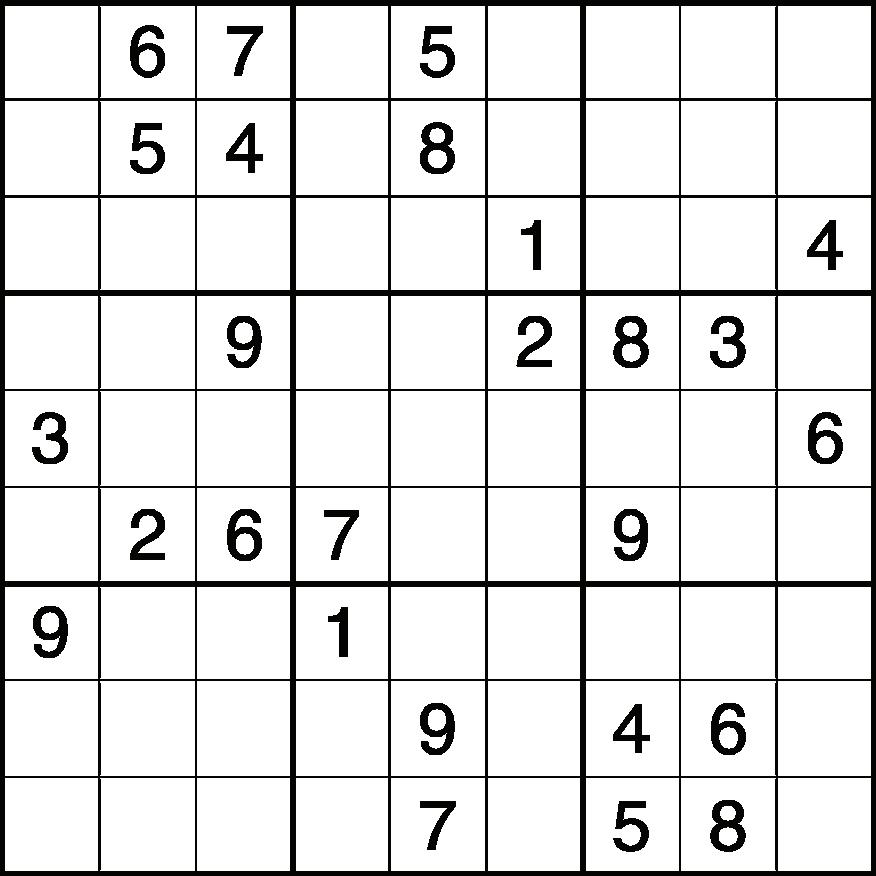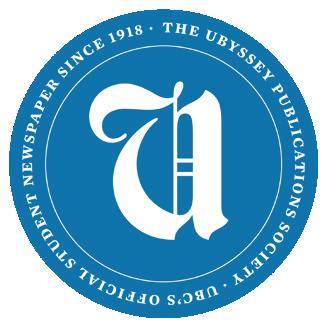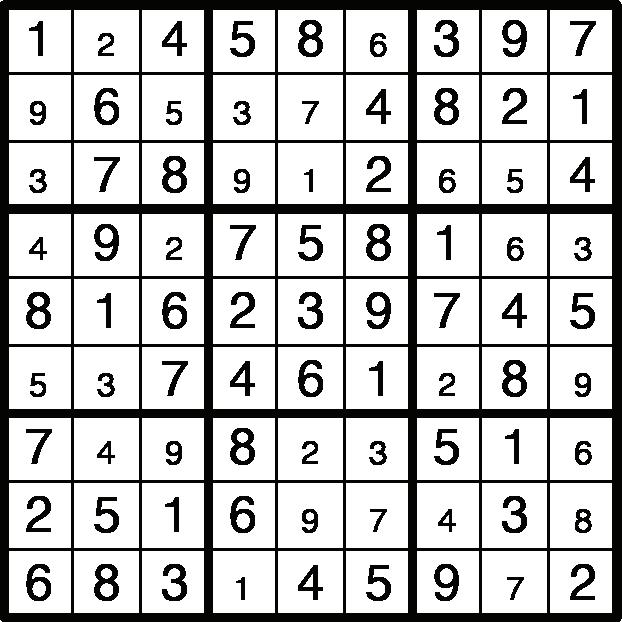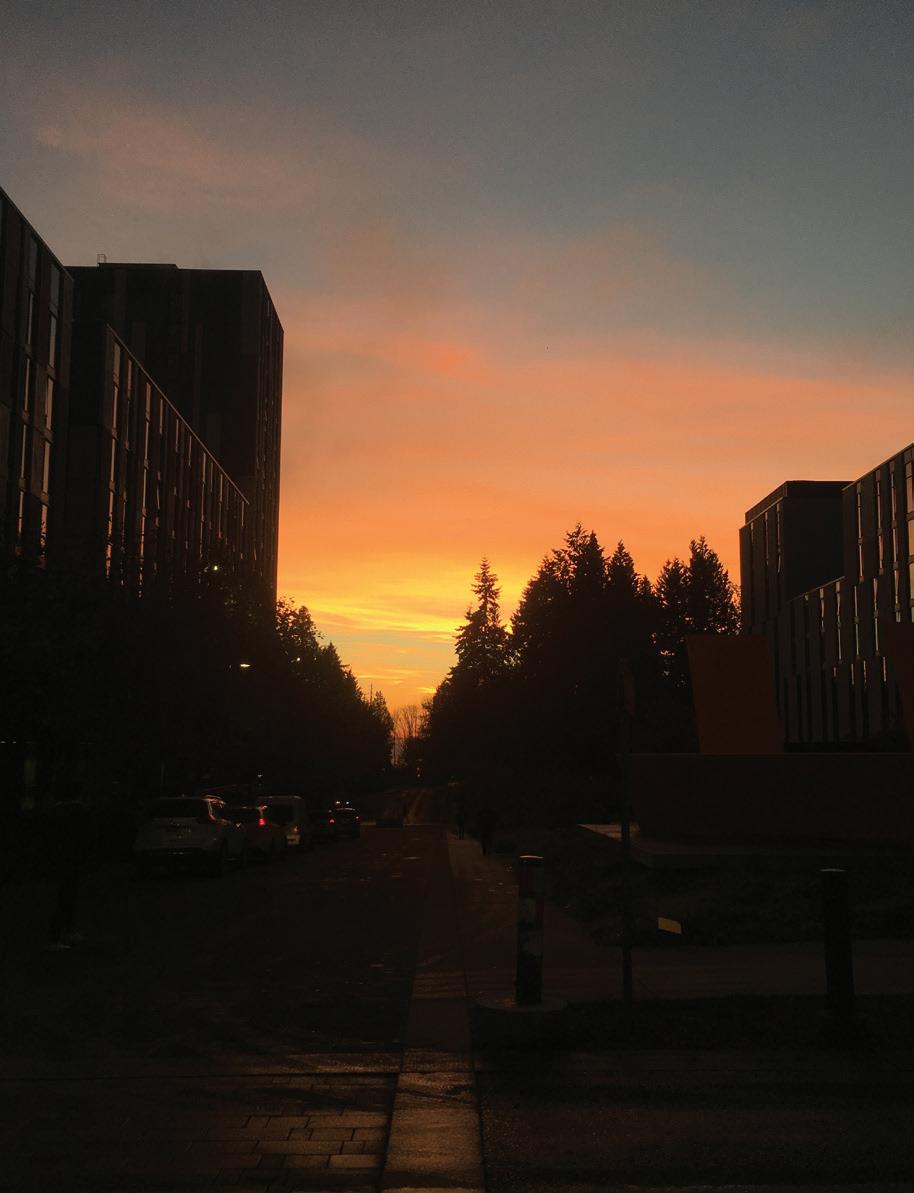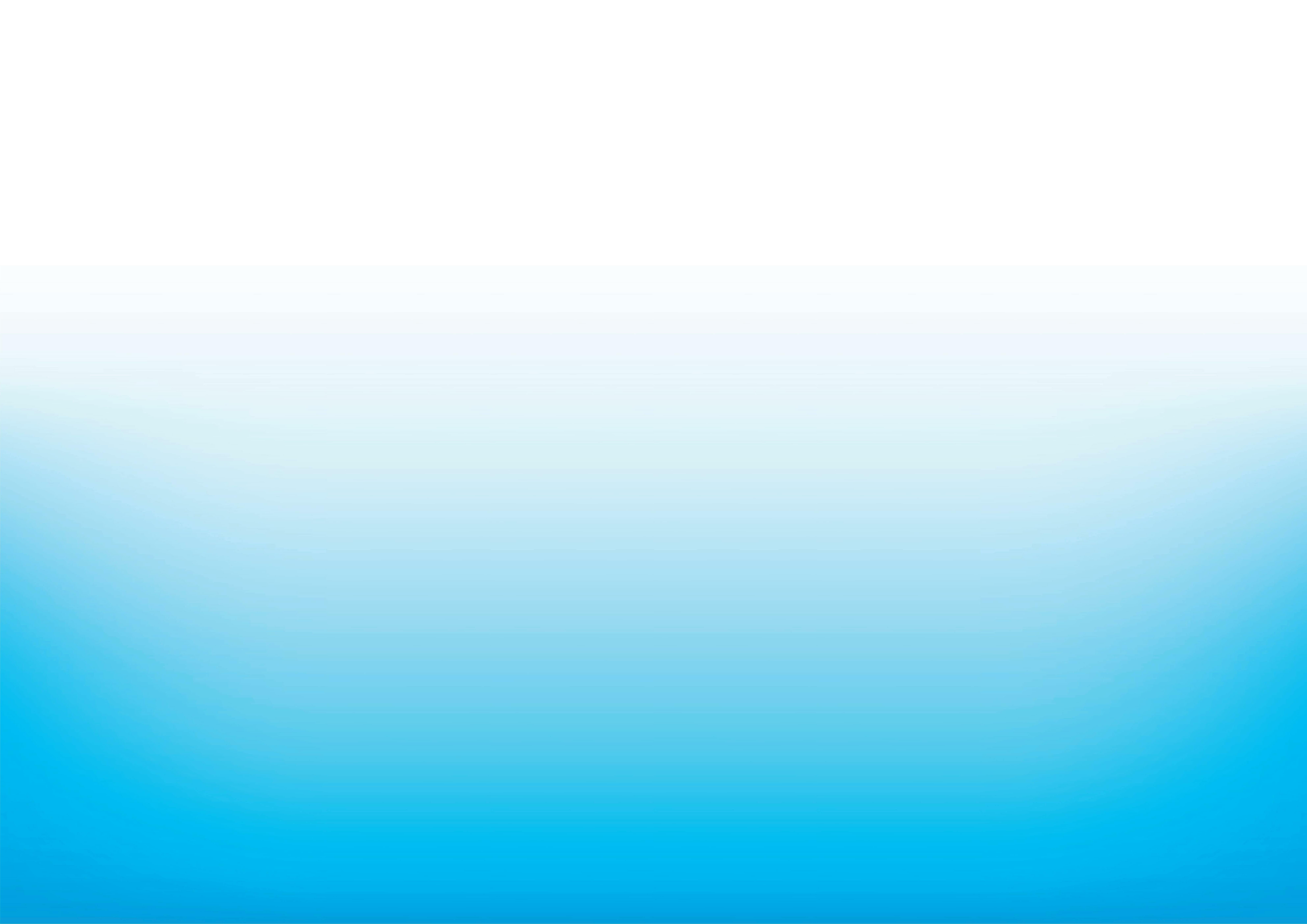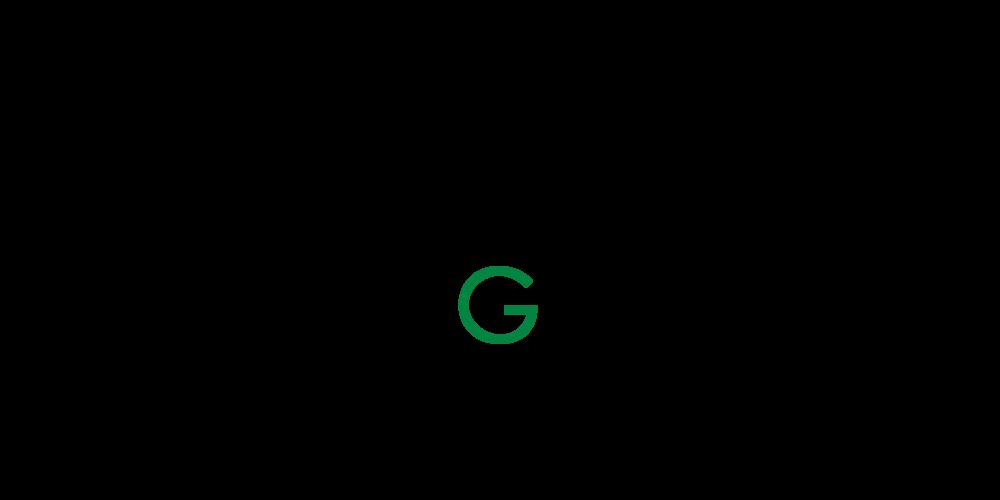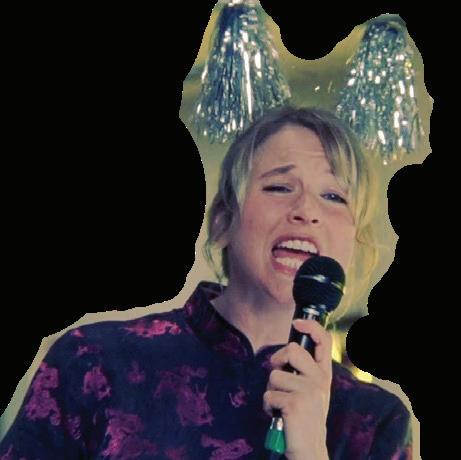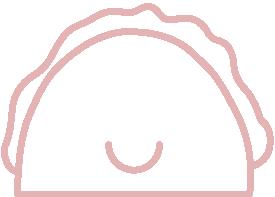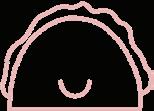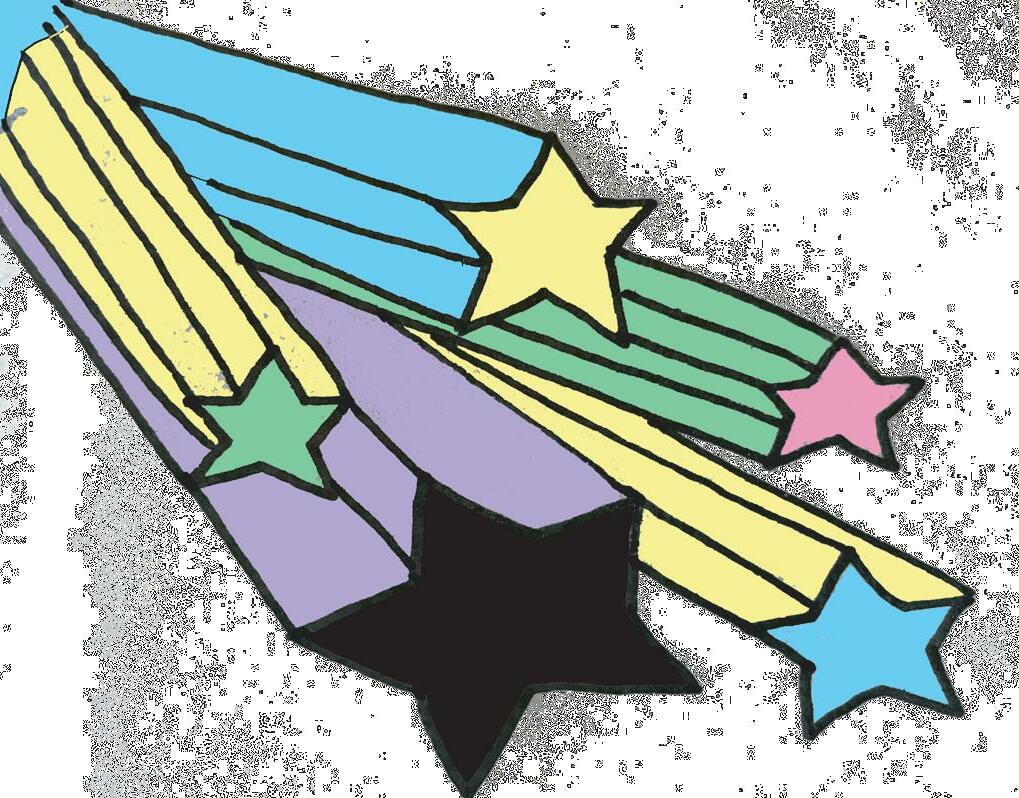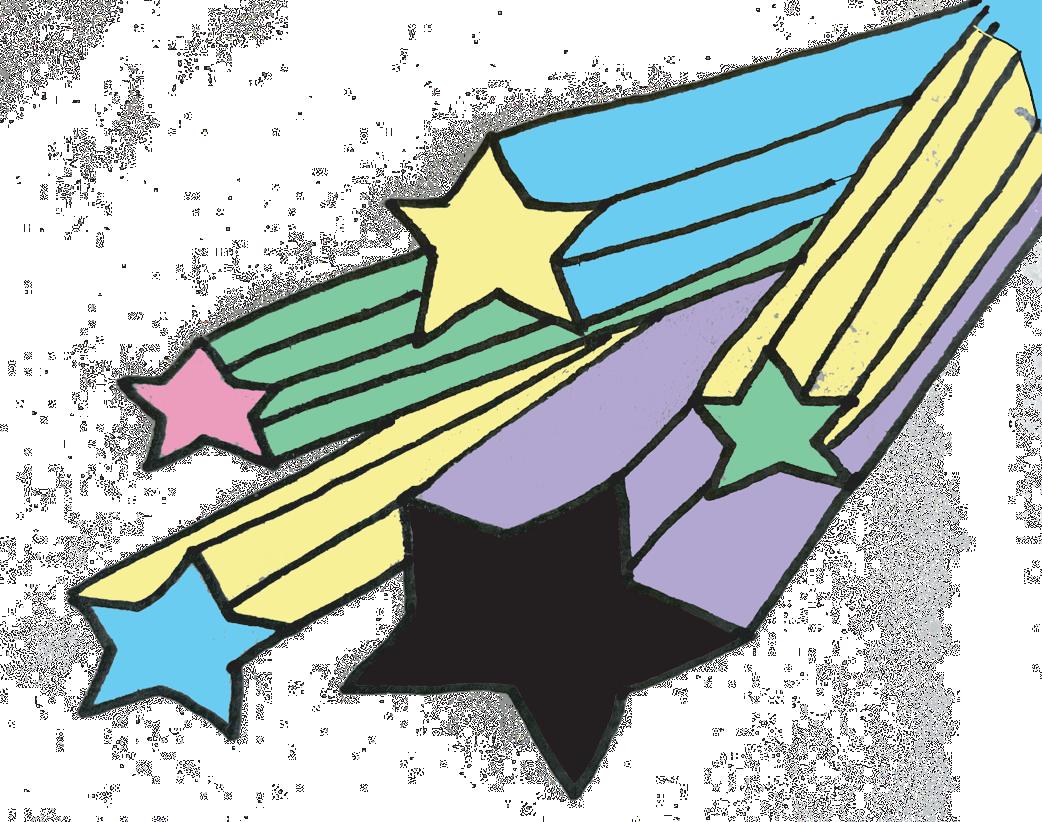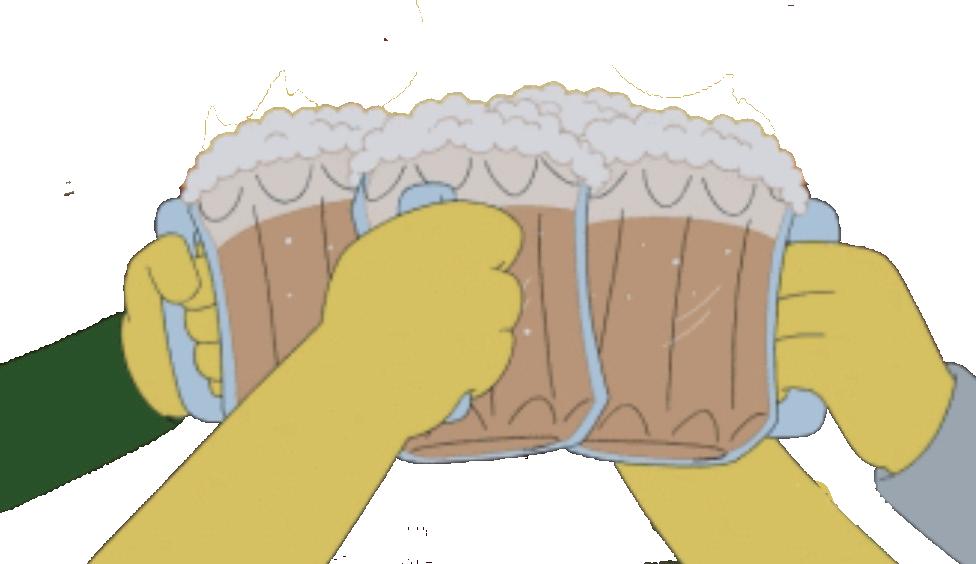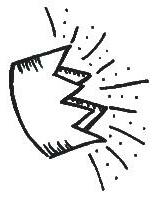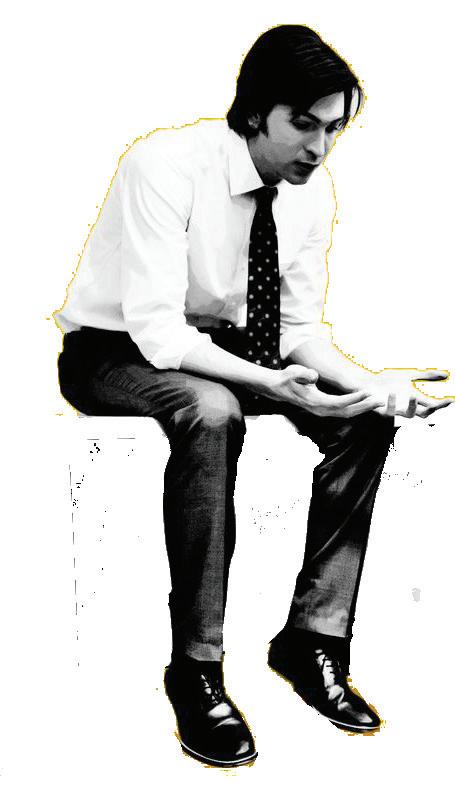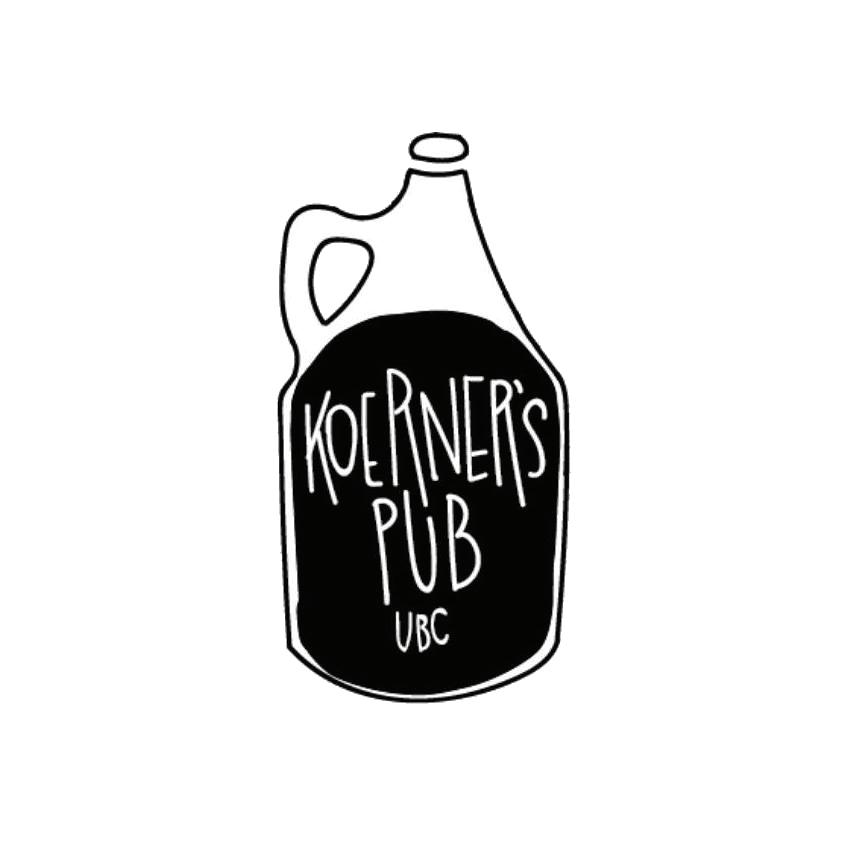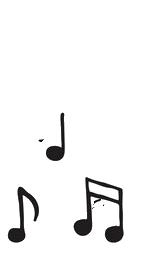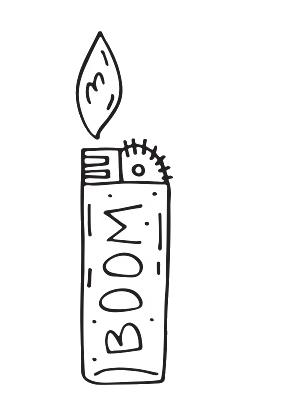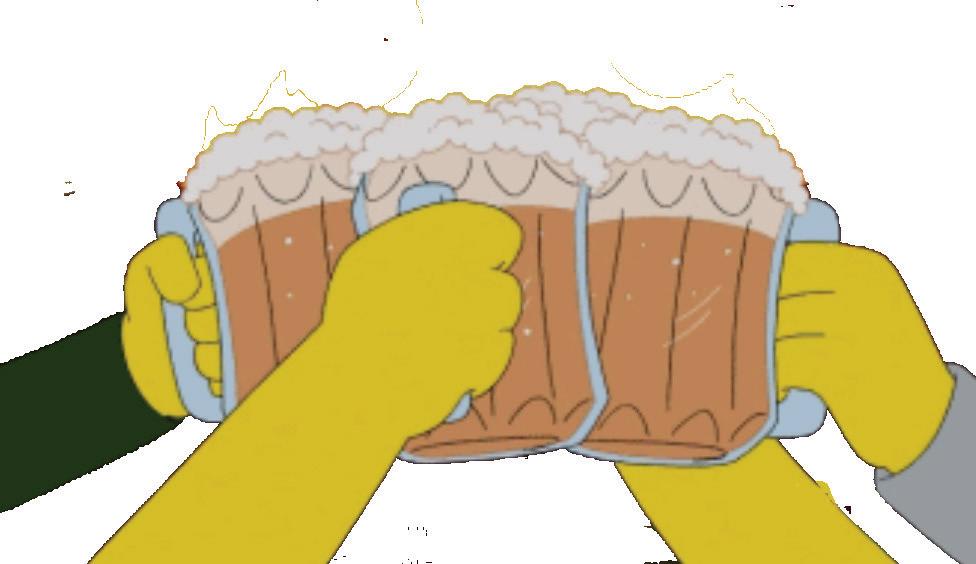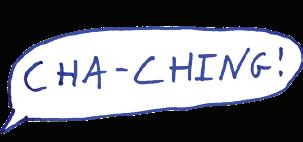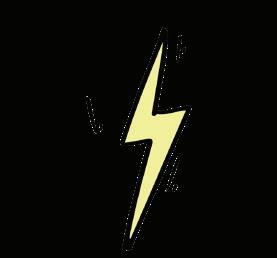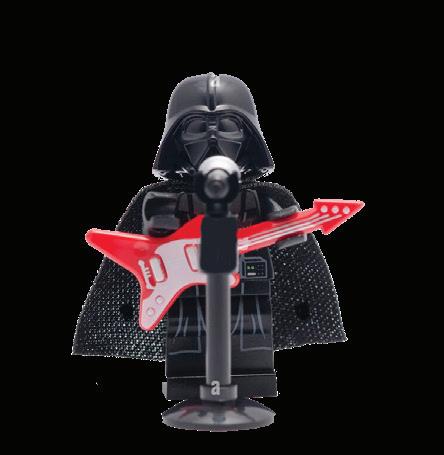AMS executive midterm reviews
Personal essay: Everything will be returned to you

07 CULTURE
09 18 20
Where the Heart Is: Manila, Philippines BLOG
FEATURES
The Dingbat: UBC bunny crime culprit caught SPORTS
UBC Volleyball celebrates Pride Night

AMS executive midterm reviews
Personal essay: Everything will be returned to you

07 CULTURE
09 18 20
Where the Heart Is: Manila, Philippines BLOG
FEATURES
The Dingbat: UBC bunny crime culprit caught SPORTS
UBC Volleyball celebrates Pride Night
account, Lapatina decided to apply for an internship at the Kyiv Post, the oldest English-language newspaper in Ukraine. She got the internship in September 2020 and worked for the paper until its brief closure last year. Lapatina now works for The Kyiv In dependent, an outlet started by some of the journalists who were fired from the Kyiv Post for defending editorial independence, according to its website.
For the last two years, Lapatina has been working full-time as a jour nalist while studying, so she hasn’t felt like a ‘normal’ student. This year, when the UBCO transfer student came to the Vancouver campus for the first time, she meant to take a break from writing, especially as she started to feel burnt out this August.
racism, sexism, homophobia, transphobia, harassment or discrimination. Authors and/or submissions will not be precluded from publication based solely on association with particular ideologies or subject matter that some may find objectionable. Approval for publication is, however, dependent on the quality of the argument and The Ubyssey editorial board’s judgment of appropriate content. Submissions may be sent by email to opinion@ ubyssey.ca. Please include your student number or other proof of identification. Anonymous submissions will be accepted on extremely rare occasions. Requests for anonymity will be granted upon agreement from fourfifths of the editorial board. Full opinions policy may be found at ubyssey.ca/pages/submit-an-opinion It is agreed by all persons placing display or classified advertising that if the UPS fails to publish an advertisement or if an error in the ad occurs the liability of the UPS will not be greater than the price paid for the ad. The UPS shall not be responsible for slight changes or typographical errors that do not lessen the value or the impact of the ads.
Raising her hand in her interna tional relations seminar, Anastasiia Lapatina knew that, yet again, no one would agree with her. She was scared of coming off as “an obnox ious emotional Ukrainian,” and was so nervous she was shaking. But she knew her opinion was well-consid ered and felt she needed to say it.
Everyone constantly talks about all of the hideous crimes commit ted by the US, but then no one ever talks about Russia, and moreover, no one ever recognizes that the US has actually done a lot of good in many places, including Ukraine,” said Lapatina.
As she anticipated, no one else in the class agreed that the US is not always the villain.
“It is extremely lonely being [at UBC],” said the Ukraine native to The Ubyssey in October. “Especially because as a politics student, class discussions touch on topics that are very related to what’s happening at home, and very often I have very unpopular opinions.”
Once the seminar ended, she broke down crying.
“When it gets to Ukraine, I obviously get emotional, and it was a very difficult day. I cried a lot and smoked a lot of cigarettes,” said Lapatina, finishing her sentence a little sheepishly.
The reasons behind her tears were far more complex than one disagreement in a seminar.
“It’s so easy to dismiss Ukraini ans as just being emotional because there’s a war. That’s a huge issue that Ukrainian influencers, academics and journalists are dealing with — people just don’t trust our authority,” said Lapatina. “They don’t trust us with our own history. They don’t trust us with our own analysis of
what’s happening on the ground.”
The fourth-year political science student isn’t just taking classes and planning for graduation. As a national correspondent for The Kyiv Independent, Lapatina has been re porting on the Russo-Ukrainian war since Russia invaded Ukraine this past February and has worked as a journalist in Ukraine for the past two years. Lapatina is still reporting on the war while she is on campus.
Lapatina never planned to be a journalist. Her career is an acciden tal consequence of the pandemic, the war and a newfound love of writing.
When COVID-19 hit in 2020, Lapatina moved back home to Kyiv for the first time since she left for high school. Lapatina attended Brentwood College School, a board ing school on Vancouver Island, and then spent the pre-pandemic half of her first year at UBC Okanagan. While she was living in Canada, Lapatina hadn’t kept up with the “local scene” in Ukraine. “[I knew] the broad things, like that we elect ed a comedian.”
Lapatina needed something else to do besides online school, so she tried to catch up with what had happened while she was away and get involved locally.
“I started looking around and I found this little Ukrainian youth-run media [group],” said Lapatina.
The group was an Instagram account that, at the time, had a few thousand followers and was run by about three dozen people writing news, according to Lapatina. She decided to join.
“I wasn’t like ‘Oh, I’m gonna be a journalist.’ I just knew that I had the skill, and I could try applying it somewhere temporarily while I figured out how to get like ‘a serious job,’” Lapatina said.
While writing for the Instagram
But her sabbatical lasted less than two weeks. As her boyfriend had predicted over the phone, Lapatina began to feel restless after a week and a half of enjoying student life in Vancouver, and felt the need to write again. Now she’s back to balancing school, writing and pod casting.
Lapatina once envisioned that she would stay in Canada after her undergraduate degree to get her master’s and PhD, but now she just wants to get back home. She’s not quite sure what her future will look like, but she knows she wants to be back in Ukraine.

“It’s a very cool experience to be a student, but it also feels very lone ly,” said Lapatina. “And I also know that this is not where I belong, and this is not where I should be. [Being in Vancouver] is just a temporary measure for me to get my degree.”
Lapatina was granted special permission to take three of her finals early so she could have a full month and a half at home during the winter break.
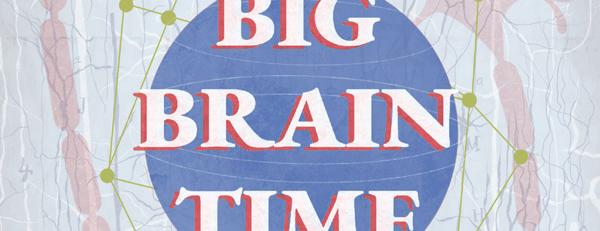
She will be using some of her time off to attend a conference in Washington, DC this December, where she plans to meet with literary agents about a book she is working on.
As Lapatina talks about going home, the weight of her isolation from living abroad is clear.
“You sit in your room, and something happens like an air strike or something [else] tragic and you’re upset. Or you’re scared that your boyfriend might die because he’s a soldier and he’s fighting. Or you’re scared that your country can get nuked, and your mom bought a gas mask and you have to deal with that and all of these emotions and you can’t really share it with anybody,” Lapatina said.
“In the moment, I feel like that’s so unfair. I just want to curl up and cry and be sad and [for] people to take care of me. I don’t want to go out of my way to find support,” said Lapatina. “I don’t expect Canadians to [understand]. It’s impossible to feel what we’re going through.” U
members will vote you in!
A November 1 feature article said that the Disabilities United Collective is able to provide financial help to students seeking an autism diagnosis. Currently, the collective does not provide this service. The Ubyssey regrets this error. An October 31 science article misspelled Abul Bashar Rahman’s name. The Ubyssey regrets this error.

Student exam invigilators at UBC’s Centre for Accessibility have successfully unionized after a three-week campaign. In an an nouncement posted to its website on November 8, the Canadian Union of Public Employees (CUPE) BC said the student workers will join CUPE 2278 — the union that currently represents teaching assistants, tutors, markers and instructors in the English Language Institute at UBC. Exam invigilators are a group of predominantly graduate students who administer exams for students who require accommodations through the Centre for Accessibility, according to the announcement.
Interim UBC President Deborah Buszard announced Frank Laezza’s appointment as UBC VP finance and operations in a broadcast message on November 15. Laezza is currently the chief financial officer at Murdoch University in Australia. In the role, Laezza will be respon sible for managing UBC’s finances and capital resources. This includes overseeing UBC’s annual budget — although Laezza will be joining UBC in March, two weeks before the budget usually goes to the Board of Governors for final approval.
After 11 years at the AMS, Managing Director Keith Hester left his role on November 3. Hester was the most senior permanent staff member at the AMS. He oversaw its business es, events, communications and financial and administrative affairs.
Celia Chung, the current human resources manager, was appointed interim managing director according to a statement from AMS President Eshana Bhangu. In an email, Bhangu wrote she could not comment further on Hester’s departure due to privacy and employment laws.
According to a quarterly report released by the AMS, only 81 of its Firstweek kits sold this year. Each one was originally priced at $49.50. AMS Senior Communications and Marketing Manager Eric Lowe said the kits always sold out in the past. He said the difference this year was that they did not include the Wel come Back BBQ tickets. Welcome Back BBQ tickets were eventually sold with the kits for $99 after Sep tember 2. The events team is looking at how to make the kits more appeal ing to students for next year. U
Some international students and student advocacy groups say the federal government’s recent decision to temporarily scrap the cap on international student working hours is a welcome change.
The policy move, announced in October, is intended to help address Canada’s labour shortage, accord ing to Immigration, Refugees and Citizenship Canada (IRCC) Minister Sean Fraser.
“From November 15, 2022, until December 31, 2023, international students who are in Canada and who have off-campus work authorization on their study permit will not be restricted by the 20-hour-per-week rule,” read the announcement from IRCC.
“This is a big win for interna tional students,” Melissa Chirino, chairperson of the BC Federation of Students, said in a Federal Student Advocacy Alliance press release from October 7.

This is not the first time the federal government has removed restrictions on international stu dent working hours. International students who worked in industries designated as essential were tempo rarily permitted to work beyond 20 hours in April 2020 early on in the pandemic.
Laksh Agarwal, a first-year in
ternational student in the Faculty of Science, told The Ubyssey he’s happy the federal government altered its policy, saying it would help with pay ing tuition and gave him “a lot more room to work with.”
International students in Canada pay an average 430 per cent more than domestic students, according to the Federal Student Advocacy
Alliance statement.
“These fees are also almost entirely unregulated, and in some cases, fees have gone up more than 20% year to year,” the FSAA said in a press release.
Dorris Li, a third-year biology international student, said the exten sion provides a “good opportunity for international students,” especially in
the summer.
Cecilia Park, a second-year international student in the Faculty of Arts, shared similar opinions, and said she feels the decision should be made permanent, a call other inter national students and groups across Canada agree with.
“This gives a lot more flexibility and freedom to me,” Agarwal said. U
threshold will also be indexed to annual inflation.
Additionally, monthly pay ments for those who make more than $40,000 a year will be capped at 10 per cent of their household income, instead of 20 per cent under the previous iteration.
“Starting today, more graduates can focus on building their careers, instead of worrying about student loans,” said Carla Qualtrough, the minister of employment, workforce development and disability inclu sion, in a November 1 news release. “[T]his change will ensure more Canadians have more flexibility when paying for school.”
For now, the changes to RAP are not applicable to the BC Re payment Assistance Plan. The new threshold also falls short of the Liberal government’s promised target of $50,000.

accessible for a lot of low-income students like myself,” Fischer said. “I feel like we are oftentimes overlooked.”
Some student advocates have pointed out that neither of the re cent policy changes affect private loans or lines of credit, which tend to have higher interest rates and account for around 30 per cent of all student loans. The changes also do not provide long-term solutions to the debt crisis, such as unconditional loan forgiveness, increased availability of grants and a provincial tuition freeze.
Yong Senior Staff WriterThe Canadian government an nounced it will eliminate interest on federal student loans, drawing both celebration and calls for further action from student advo cates.
As part of its fiscal update on November 3 — which heavily fea tured affordability — the federal government announced plans to eliminate interest on federal stu dent and apprentice loans starting from April 1, 2023, immediately af ter the two-year freeze on student loan interest expires.
Student debt remains a signif icant barrier to socioeconomic mobility for young Canadians.
Between 2000 to 2015, 1 in 2 post-secondary graduates carried student debt past graduation, with an average debt burden of $28,000. Paying off this debt usually takes between 9 to 15 years with the Stu dent Financial Assistance program.
The announcement follows an other change from the government on how student loans are paid.
On November 1, changes to the Repayment Assistance Plan (RAP) — an application-based program that assists those facing financial difficulty to repay their loans — took effect. Single-mem ber households making below $40,000 a year can now qualify for a zero-payment plan, which is more inclusive than the previ ous $25,000 threshold. The new
Chris Fischer, a fifth-year biology student from rural BC, is the first person in his family to attend university. He said while his parents fully supported his de cision to attend UBC, the financial burden of paying for university fell almost entirely on him.
Fischer relied on a mix of grants, scholarships and govern ment loans to finance his educa tion, which means that he will be graduating with around $30,000 in student loan debt next spring. He said that the prospect of having to pay off the loan plus interest, in addition to financing medical school and covering living costs, was “pretty terrifying,” so he was pleased to hear the federal govern ment’s plan to eliminate interest.
“It’ll just make education more
Erin Co, the AMS VP external and chair of the Undergraduates of Research Intensive Universi ties (UCRU), has been involved in student debt campaigns since she started working for the AMS three years ago. Co said while the recent changes are “no small feat,” there is more work to be done.
Co said policies like loan forgiveness are still needed to address the skyrocketing cost of living facing graduates. She also said navigating the loan regime is a “daunting task” that students are often ill-equipped for.
“No one should be paying off student loans 30 years after graduating, it’s simply not feasible if someone wants to start a family and buy a house,” Co said.
In the upcoming federal lobby week, Co and other advocates from student organizations across Canada will be raising these and other affordability concerns to policymakers with the hopes that they can gain more ground.
“It’s a great step forward, but hopefully not the end.” U
“This gives a lot more flexibility and freedom to me.”TATIANA ZHANDARMOVA / THE UBYSSEY FINANCIAL
“It’s a great step forward, but hopefully not the end.”
TATIANA ZHANDRAMOVA / THE UBYSSEYTina MELISSA LI / THE UBYSSEY
Your AMS executives are halfway through their terms.
As candidates, they promised to im prove the student experience on issues from affordability to community build ing. The Ubyssey spoke to all five about what progress they have made on their goals and what they intend to accomplish
through the rest of the academic year. These aren’t report cards, and we know not all executives’ progress can be easily quantified. Rather, we want to give you an analysis of where the execs stand on promises made when you elected them and goals presented at AMS Council in June.
Because of the unexpected by-election this fall, we’ll also be reviewing progress within the VP finance portfolio as a whole rather than an individual executive. Here are the summaries of how each executive has done so far. Find the full midterm reviews at ubyssey.ca/news
Bhangu has had a busy year balancing being AMS president and serving as interim VP finance from July to September, but she said her core priorities have not shifted. She has advocated for sustained food security funding with VP Academic and University Affairs Dana Turdy. She has seen success in meeting quorum for the AMS’s Annual General Meeting — only the third time in the past 40 years. But, under her watch, AMS/GSS mental health coverage decreased from $1,500 to $1,000, although it was raised to $1,250 following widespread student complaints. Due to her heavy workload as president and interim VP finance over the summer, she has also faltered in some of the bureaucratic aspects of the AMS, such as finalizing the AMS Strategic Plan.

So far this year, the AMS has seen three different students serving as VP finance — former VP Finance Rita Jin, President Eshana Bhangu as interim and current VP Finance Lawrence Liu — as the AMS faces a projected $1.25 million deficit. Former VP Finance Rita Jin was working on changing the AMS’s credit card policy and expanding club subsidy access before she resigned in July. As interim VP finance from July to September, AMS President Esh ana Bhangu worked on several things, including creating a set of Indigenous finance guidelines and exploring ways to improve AMS businesses’ performance. And, in his first month in office, current VP Finance Lawrence Liu has been working on the transition to a new financial system, and plans to talk with AMS businesses in or der to address the deficit. But the departure of the AMS’s manag ing director — who works closely with the VP finance and oversees the student society’s businesses and financial and administrative affairs — could also pose another challenge to this portfolio.
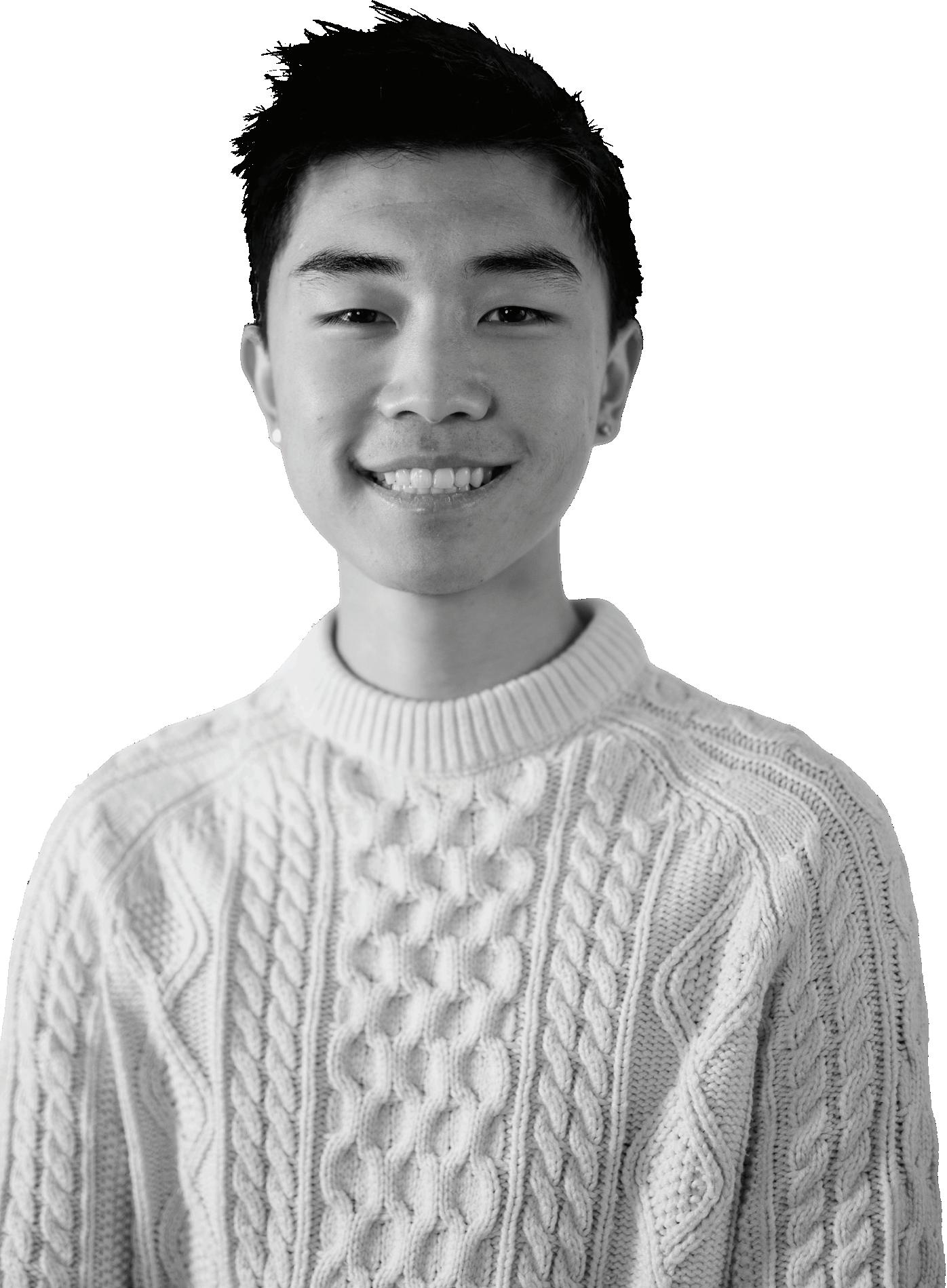 ESHANA BHANGU
LAWRENCE LIU President & former Interim VP Finance VP Finance
Eshana
ESHANA BHANGU
LAWRENCE LIU President & former Interim VP Finance VP Finance
Eshana
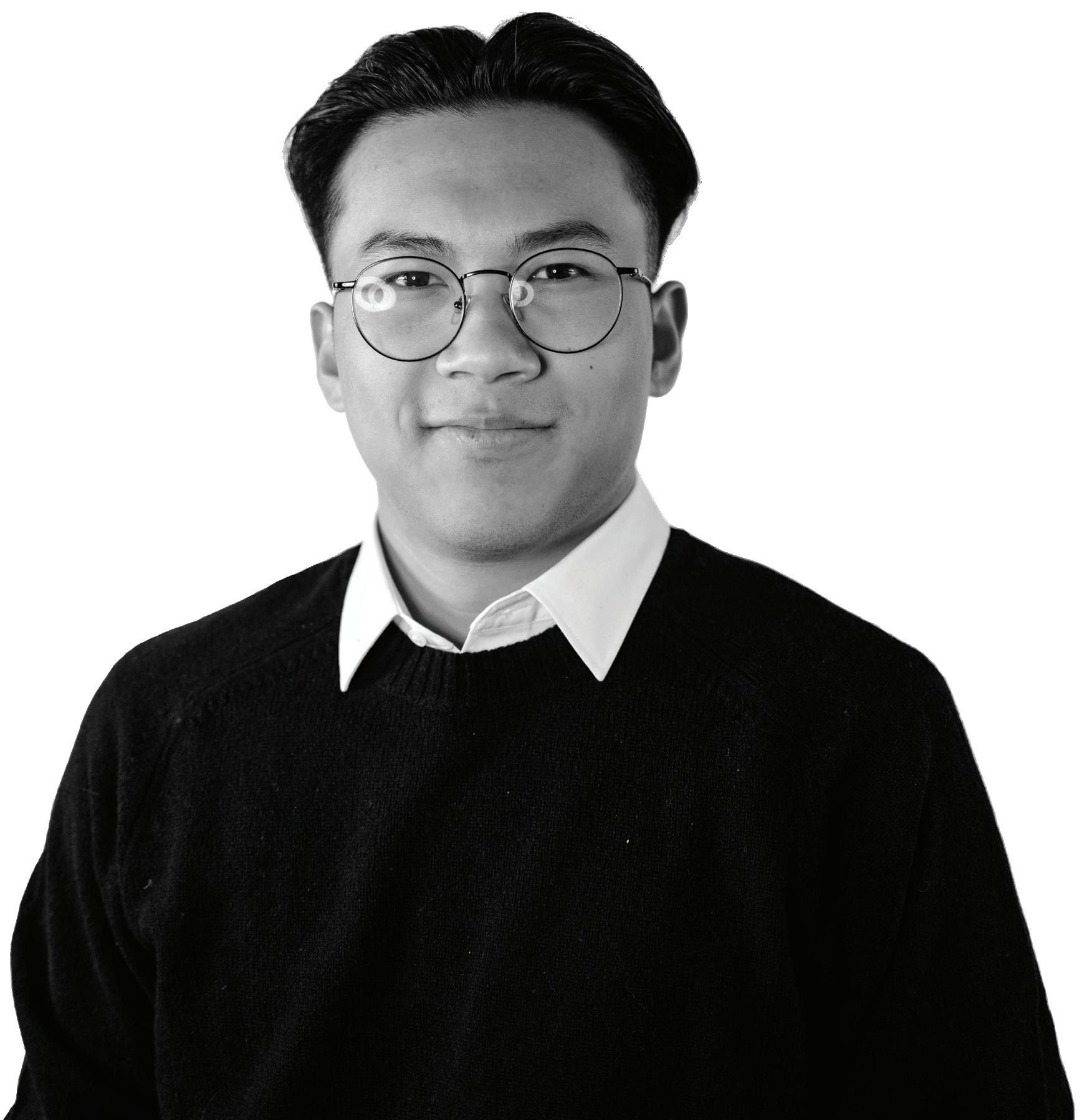
Dana Turdy ran for VP Academic and University Affairs (AUA) on a platform of affordability, health and wellness and student engagement. Turdy’s been making progress on her promises — the AMS secured $500,000 in funding for food security and pushed to get substance testing on campus. The VP AUA office has also been working to get students engaged in UBC’s decision making processes, particularly Campus Vision 2050. One promise she has not been able to fulfill so far is establishing a permanent clinic for substance testing on campus. Next term, Turdy’s focus will be working with UBC through its budget cycle and pushing the universi ty to implement the recommendations from UBC’s Student Accessibility Task Force.
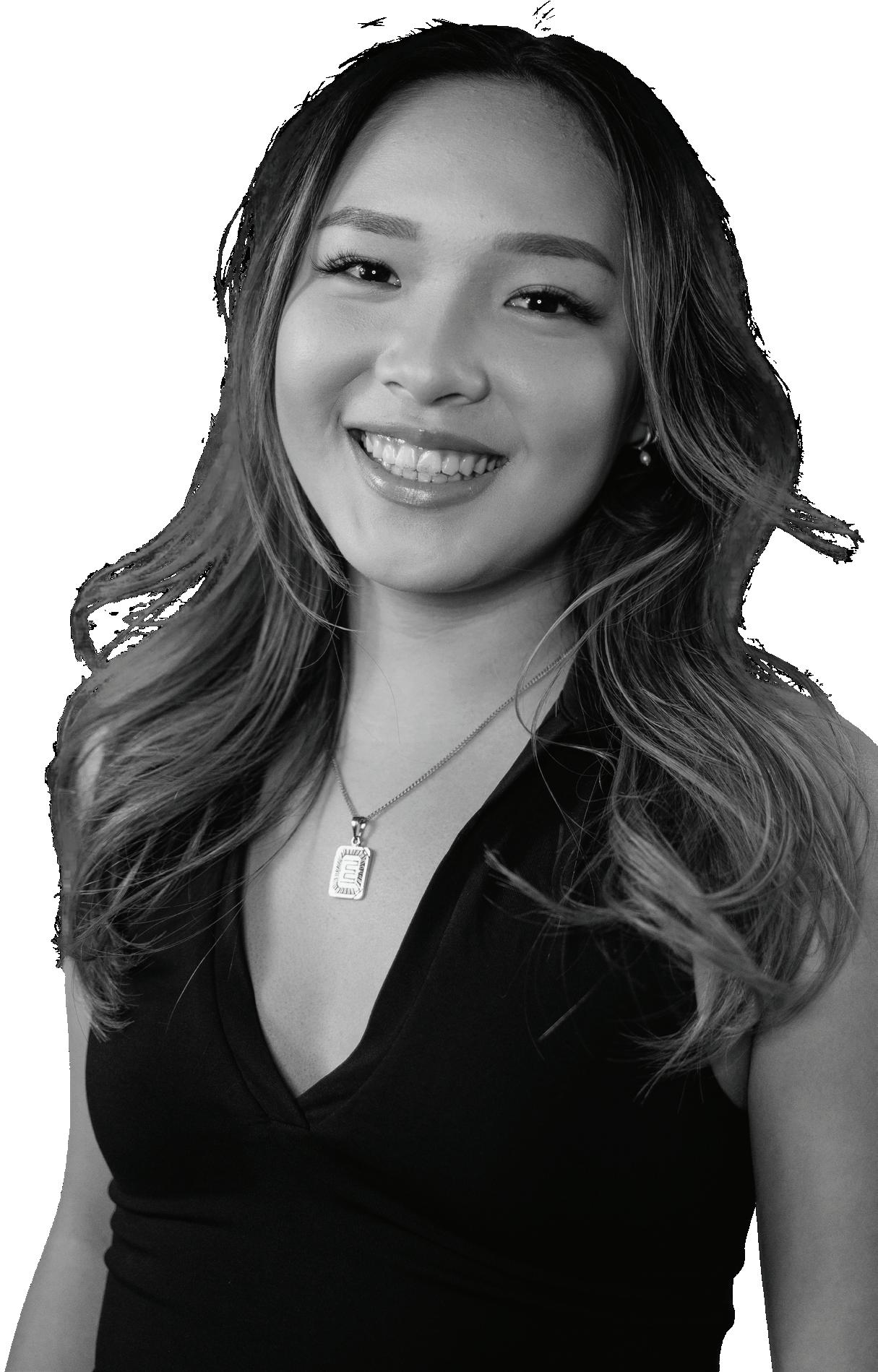
Halfway into his term, VP Adminis tration Ben Du has focused heavily on community building. He oversaw the AMS’s rebranded Clubs Fair, which saw 232 clubs booths across 3 days. Du has also reopened the Commons space on the lower level of the Nest as a club events and study space geared towards commuter students. Going forward, Du is looking to streamline club communication and the stu dent club experience with a revamp of CampusBase, expected to roll out in January 2023. Du has many plans for the rest of his term, although the timelines might not be feasible with the time he has left.
VP External Erin Co has spent her term advocating for financial aid, student wellness and transit expan sion. She, along with student unions across the country, have successfully lobbied for the permanent removal of student loan interest and a new summer U-Pass program for students not taking classes. Co is also working with the provincial government to revise its sexual violence and mis conduct policy. However, she is still chipping away at long-standing issues like securing funding for the UBC Sk yTrain expansion. She is also working on increasing harm reduction support from the provincial government.
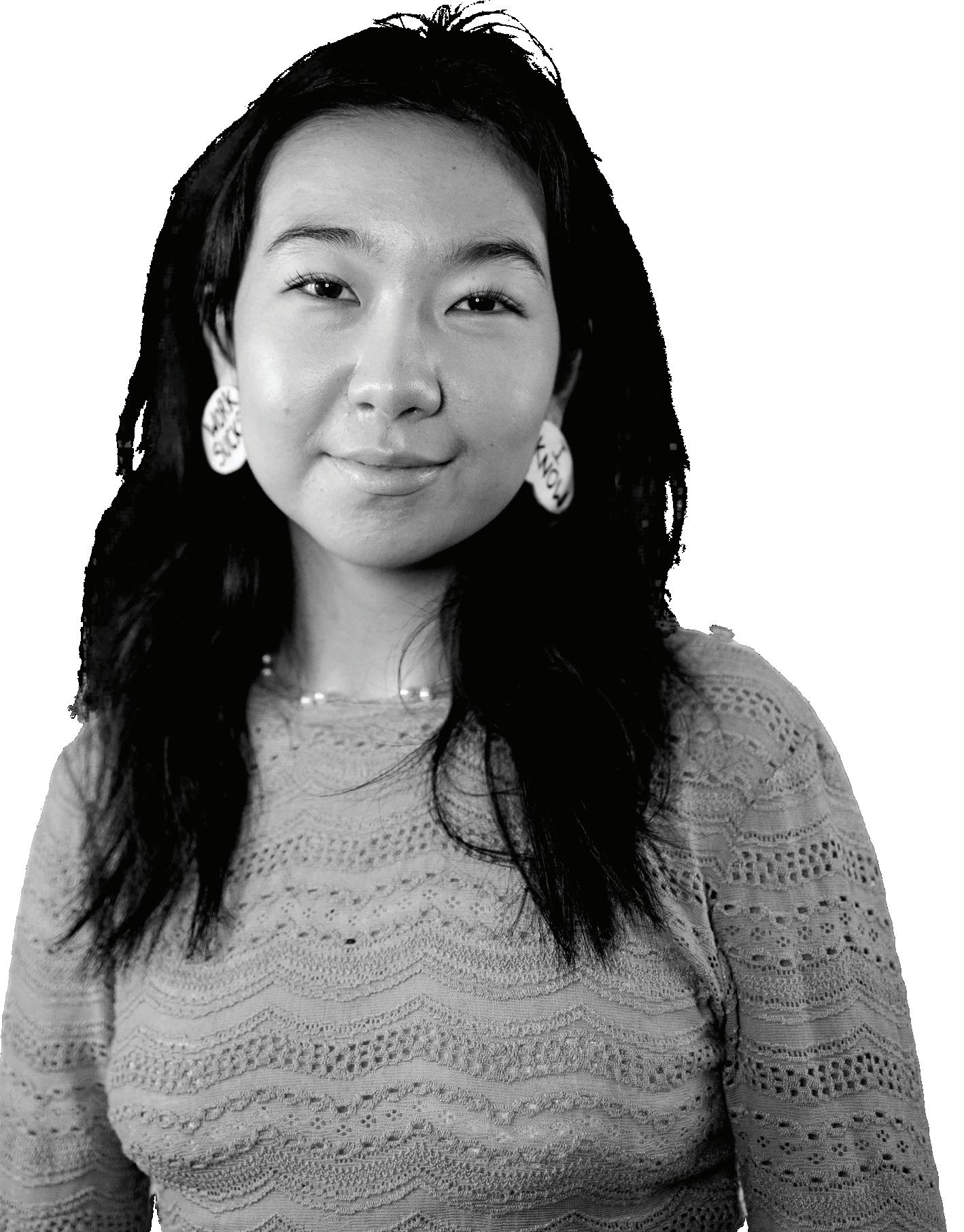
The UBC Equity & Inclusion Office (EIO) has announced the com munity-based funding recipients through the Equity Enhancement Fund.
The Equity Enhancement Fund (EEF) is an initiative that supports faculty- and staff-led projects that amplify equity, diversity and inclusion (EDI) at UBC across both the Vancouver and Okana gan campuses. The fund supports UBC’s Inclusion Action Plan. It has two running cycles, in the spring and the fall, with a total of $80,000 available at the Vancouver campus and $10,000 for the Okanagan cam pus annually.

The EIO received 59 applica tions for the EEF for the spring funding cycle, with a total grant re quest of $245,245, and selected 14 initiatives to receive funding. UBC Vancouver was awarded $42,900 across nine projects, while UBC Okanagan received $6,610 for five projects, for a total of $49,510.
One of the projects funded was UBC ARTIVISM. The annual art
festival is in its fifth year and was led by the UBC Arts & Culture District in partnership with the Exposure UBC student club team.
It took place from September 6 to October 13.
This year’s theme was Politics of the Body. “[The] body is some thing that everyone can relate to, but it also touches on matters of gender and BIPOC communities,” said Helena Miranda, the Arts & Culture District artitistic director and third-year media studies student.


Deb Pickman, the special projects, Arts & Culture District and marketing communications specialist, said, “We have all these initiatives that we want to take action on as students, faculty and staff, and a lot of times it will end up being a talk or a lecture that’s something that’s quite serious.”
“But when you can do a piece of art or a performance … I think it speaks to people in a very different way … It’s such a great place to unpack a difficult conversation,” Pickman said.
Vanessa Matsubara, a thirdyear media studies student and the Arts & Culture District artistic producer, said in-person art events “[foster] an environment where
you can learn [and] meet new people” which she didn’t get to experience in her first year due to COVID-19.
According to the team, anyone can participate and is welcome to submit their art when the time comes. For ARTIVISM’s fifth year, events ranged from workshops, performances and drag and art shows in collab oration with the Museum of Anthropology, Vancouver Art Gallery, Vancouver International Film Festival and the Hatch Art Gallery.
“ARTIVISM is really about giving voice and power to those who want to make something, to exhibit their works or [who] just want to have a safe space,” said Miranda.
Another project awarded funding was IBPOC Connections for Students, designed to support and create a safe space for students who identify as IBPOC with a common interest in climate jus tice and wellbeing.
The project is inspired by the IBPOC Wellness Mentors Program piloted from September 2021 to April 2022.
“Because [the IBPOC Wellness Mentors Program] was a pilot, we knew that we wanted to take the best parts of that particular pilot, and then see how we might be able to implement those specific aspects. And that’s where the idea for IBPOC Connections came,” said Levonne Abshire, the project lead and director of health equity, promotion and education at UBC.
“Some of those strengths we’re now bringing IBPOC students together in a less formal, casual environment that really did build on social connection and commu nity engagement … because we know that social connection and a sense of belonging does improve one’s mental health.”
The IBPOC Connection for Students program is in collabo ration with the EIO, the Sustain ability Hub and Student Health & Wellbeing, with term one focusing on planning and term two on implementation. U
Helena Miranda was the photo editor for The Ubyssey ’s 2022 magazine. She was not involved in the writing or editing of this piece.
The AMS is considering a ref erendum on UBC’s investments after releasing an Environmental, Social and Governance (ESG) report, which outlines options for the AMS to advocate toward UBC to better incorporate ESG principles in its finances and investments.
This report comes after a mo tion was passed by AMS Council in March to pen a letter to con demn the Israeli state’s occupa tion of Palestine and urged the UBC Board of Governors (BoG) to divest from nine companies, most of which appear in a UN database for businesses involved in “human rights violations concerns.”
The report explains how the university selects investments, which is done through UBC Invest ment Management Trust (IMANT) — a company wholly owned by UBC. IMANT provides the uni versity with “investment services, such as portfolio management and advisory services.”
ESG principles are factors com panies can consider when attempt ing to make ethical investments, like environmental harm, corrup tion and workplace conditions.
In 2020, the BoG implemented ESG principles in response to the climate emergency and supported the full divestment “of fossil fuels from the Trek Endowment Fund.”
The report outlines three advocacy methods the AMS could use to persuade the BoG to better incorporate ESG principles into its investments with the hopes it would increase ethical business practices.
AMS VP Academic and University Affairs and Advocacy Committee chair Dana Turdy brought the report to AMS Coun cil for feedback on the methods, with little discussion.
Turdy said the option she
believes is the best is the third — direct action or a campaign. This allows for direct engagement with the BoG and could include writing letters and reports, hav ing meetings with the BoG and running a referendum in the AMS spring election.
“[A referendum] gives us a sense of where students stand and how to move forward in advoca cy,” said Turdy. The referendum would directly ask students “whether or not they support UBC divesting from companies that commit human rights viola tions, and that can give us a very strong mandate advocating to the university.”
Turdy said in Council the Advocacy Committee was considering the feasibility of a referendum, considering they are resource intensive and often mean hiring a new staff member.
The other two options in the report are conducting advocacy research and providing education and encouragement. Both are primarily aimed toward students and would include consulting student groups, researching how to incorporate ESG principles in investments and educating the student body on these matters.
While this would allow the AMS to collect important data and increase student financial literacy, these options are also resource and time intensive, and according to the report “is somewhat outside the scope of the AMS.”
Turdy spoke about the impor tance of UBC adopting these prin ciples as “students are directly impacted, especially international students who are coming here from many different countries around the world.”
“If the university wishes to progress and really make a differ ence in the world, then it should reflect in their finances and investments as well.” U
“If the university wishes to progress ... it should reflect in their finances”TATIANA ZHANDARMOVA / THE UBYSSEY
This article contains explicit mentions of sexual assault, police brutality, self-harm and child abuse.
The experience is that of being cut with a knife. Past and present are severed; the future is eliminated; hope is lost. I inhale sharply, as though wounded, and a deep unseen terror grips my chest, like a memory, like a thing which will not release its hold on me.
I am reading Twitter’s email list of recommended tweets. The tweet in question informs me that another human being has died in Vancouver’s Downtown East side. I feel as though a memory has crawled inside my chest and taken my heart hostage. There are tremors of pain, feelings of inadequacy, a longing for a justice that I know will not be coming.
The memory comes back in flashes. The gunshot wound: purple ripples of skin and flesh around a ban dage. The bunk beds, the mattresses, the blue of the room. His face. His hands. His teeth, sharp, his smile, merciless. Him getting what he wants. My body, an object, a nothing. A feeling of fear so visceral it tran scends emotion and becomes mere reality: the wobble of the bunk bed, the cars in the street, someone screaming outside.
(Like me.)
I erect walls in my mind, attempting to stop the onslaught of sensory input returning to my conscious ness. The smell of alcohol and vomit on my clothes. The greasiness of my unwashed hair. The knowledge that I am not a human being. Rather, I am homeless.

I breathe deeply. I attempt to steady myself. My name is Bradley Astra Aldridge, I mentally repeat. My breathing quickens. I attempt to slow it. The year is 2022. I look around the room, at the obvious indicators of student hood, my notebooks and my textbooks. I am in my room on UBC’s Point Grey campus. I attempt to re-enter my body, even as the fear grips me. And I am safe.
It is 2020. Soon the world will start ending for everyone else. Right now, it is only ending for me. I lie down on the mattress at the homeless shelter where I live, and as I close my eyes, a terror grips me. A blue terror. An unnamed terror. A terror deep and hungry. Something’s not right, it says. I’m not safe here, it says. I felt the same refrain echoing in my blood as a sexually-abused child.
In 2020, I am still performing in the same play I did as a child. All that has changed are the actors filling the roles. The roles are: The Good Child, who obeys; The Bad Child, who remembers; The Abuser, who terrorizes; and The Complicit, who enable and turn their eyes away.
My father has been replaced in his role as terrorizer by a tall man with carefully-held hands and a blank ex pression. He works at the shelter. The role of The Com plicit has been assigned to a bubbly and friendly social worker, who expresses a great deal of faith in me until the moment in which I make the accusations against her co-worker public.
Being the object of abuse, the desperate to please,
It is 2020. I am disintegrating. I feel the true terror that makes itself known as something distinct from mere ordinary fear. I feel terror when a certain shelter worker jangles his keys to my room, and the reality of my situation is made clear. I feel it when I read news stories about sexual assault, and the small, meaningless details remind me of what it is I am suppressing. I feel it most of all when I lie down to sleep and every cell in my body screams, Run. Leave. Fight back. Do anything other than this.
I am learning that men other than my father are capable of being so cruel.
My hands are covered in a mixture of blood and scabs, a consequence of my untreated eczema. No one seems to care. A fellow shelter resident who has occasionally shared rooms with me has the bleak hobby of lifting up his t-shirt to reveal a gunshot wound he received at the hands of the police.
“Did I tell ya I got shot?” he asks, routinely, almost cheerfully. There are purple shockwaves around the bandage. It makes me sad in a way for which I have no words.
In 2022, fear of a different kind grips me. It is not the blue terror of frozen, wordless stares. It is not the inextin guishable knowledge that something is wrong, something is wrong, I can’t stay here, I have to leave. It is the reasoned fear of safety, the anxiety that something will go wrong because nothing currently is: it is the fear of one with something to lose.
Sure, my future at UBC seems to beckon to me, as though I have earned it, as though I am really here, as though this isn’t a mistake, but what about the feeling? The thing that shivers and twists inside of me, crawling up my spine, whispering, They don’t really know you. If they did, they’d disown you. No one could ever love you. You’ll never survive. You’ll have another breakdown and end up in the hospital, certified, delusional. Alone. Unloved.
I tell myself the fear is irrational. I buy notebooks with flamingos on the cover. I make plans to have break fast with my friends on Labour Day, some celebratory christening of the school year, some belief, however weak, in my potential.
In the hospital waiting room, I am 17. In the hospital waiting room, I am 19. In the hospital waiting room, I am 23. In the hospital waiting room, I am 26. Time does not exist here. All that exists are the off-white walls, the beige patient clothes, shapeless, formless and unflatter ing.
I am 17 and being certified for suicidal ideation. I am 19 and being certified for actually trying to kill myself. I am 23 and being certified for being “delusional regarding a recent sexual assault.” I am 26 and I am not certified at all. This time they tell me I am healthy.
I am traumatized and I am anxious, but this is a response to my experiences of adversity, not a psychosis.
When I was a Crazy Homeless Guy with bloody hands (‘I’m not touching that, it’s disgusting,’ said the hospital employee who refused to put a band with my name on my wrist) and an unreliable story (‘delusion al regarding a recent sexual assault,’ read the Mental Health Act certificate) and people who say he’s crazy (‘We’re concerned about your mental health,’ said the Important Management Man at the shelter to whom I told my story before he called me an ambulance and said he’d call the police if I didn’t go willingly), he is not believed to the same extent as a clean human being, a middle-class human being, a Real Human Being.
I am 26, and I am watching patients bicker and bait each other, first-timers who’ve never been certified ex pressing indignation and confusion at the concept that
the police can pick you up and drop you off somewhere other than jail, leaving you with nothing to do other than wait, drink small cups of orange juice and hear the muffled anger of patients in the so-called quiet rooms screaming.
I am 26, and a fellow patient doesn’t want to give his phone to the nurses.
It’s just temporary, says the nurse. No, he says insistently.
We’ll give it back, she says cheerfully. Everything will be returned to you.
The man I do not know is defiant. He says some thing about a lawyer. He seems angered, willing to fight, capable of asserting himself. I know how this story ends. A few minutes later, security arrives. The nurse, now backed by ominous figures in uniform, tells the man that he will have to hand over his phone. He looks small. He looks defeated.
I read the news stories: ‘Crazy Homeless Guy randomly attacked people for no reason, more at 11!’ I read the editorials: ‘These mentally-ill homeless people just can’t integrate into society because they’re so ill, we’ve gotta re-open Riverview!’ I scroll through the tweets: ‘these progressive idealists, who say homeless people are reg ular people just like anyone else, have clearly never met the crazy homeless people I see!’
And so, when people tell me they believe me, that what happened to me was horrible, that I am resilient and strong and inspiring and brave, I am struck with the real ization that if the people who see me now had seen me when I was just another homeless guy covered in vomit and alcohol, my hands bleeding and my hair greasy and unwashed, they would’ve flinched. They would have seen the circumstances and not the human being.
My humanity is dependent on an act that I don’t know that I can sustain, the performance I have been giving since childhood, the I-am-just-like-you act, The Good Kid, the mandatory aura of respectability.
In 2020, I pick up my clothes from the shelter where I am no longer allowed to stay. The process is as humiliat ing as possible. I am not allowed inside the building, so I stand outside on the post-apocalyptic streets.
I knock on the door several times to give back pos sessions that are not mine, that were given to me by mis take. The staff are hostile and disinterested. I am fooling
no one. I wheel my suitcase up the street, toward the hotel room I have booked. My bleeding hands are sore. My betrayed soul is sore. Keep going, I tell myself.
For what? asks a part of me.
I don’t answer.
In 2022, I can’t stop thinking about that nurse’s words to the man who was reluctant to part with his phone. Everything will be returned to you.
As though trials are temporary. As though, for a mo ment, we are parted from our desires. For a moment, we find ourselves bleeding and defenceless. For a moment, we wake up in homeless shelter bathrooms, the injuries we have no memory of incurring cascading across our inner thighs. For a moment, we think that God is dead, and humans are wretched creatures, and there is no hope for restitution and recovery.
Then, we wake up one day, and we are human beings. We are loved, and we are safe, and we are believed by those whom we trust, and who trust us. And we can’t quite believe it, that fortunes should change so dramat ically.
I think regularly about the people I have left behind, the people who are still homeless.
I think about the smug venom with which individ uals speak on the poverty and desperation they have never experienced, declaring that people living in tents must be forced to accept alternate housing. The assumption, of course, is that there is shelter. And the assumption that the places that call themselves shelters are safe, that they could never be open hunting grounds for sadistic predators with an ease of access provided by their colleagues’ indifference.
I think about Chris Amyotte, who is no longer living because he was seen as a threat while he begged for help. I think about the fellow shelter resident I used to know, who would show me his gunshot wound.
I don’t know what it is that I have lost, but I know that it will not be returned to me. I know that tonight when I go to sleep, the blue light of night will come, and I will feel afraid. Justifiably, given the context of my life. But when this blue terror threatens to tell me that there is no hope, I will repeat to myself:
My name is Bradley Astra Aldridge. (The terror shiv ers. It fades.) The year is 2022. (I remember, I remember, I can’t forget.) I am in my room on UBC’s Point Grey Cam pus. (The fear is still there. My room is still blue. But I have something else.) And I am safe.
(I have hope.) U
“Where are you from?”
The question that haunts every third culture kid inevitably squeezes itself into every conversation during the first week of university. Whenever it’s asked, I’m afraid of being considered pretentious, but my response has never changed.
“I’m half Japanese and half Canadian but I grew up in the Philippines,” I always say reluctantly.
It’s not that I want to make my life sound more interesting or seem exotic. I struggle to pinpoint my identity to a single place.
In my early teens, I wanted nothing more than to live the quintessential American life as seen in a Netflix show. To ride a yellow bus to school with the people I’ve gone to school with since kindergarten. To go home to my childhood bedroom during university breaks and get lunch with all my friends who were doing the same. To feel a sense of belonging and patriotism to a small town where every one knows everyone.
While in many ways, my life did fit that of the typical Netflix original — I played sports after school, I hung out with my friends on weekends, I sat at the dinner table with my
family every night as they asked the classic — “What did you learn at school today?” — question. But in many other ways, it didn’t. The norm at my school was to move away after a few years. There were only 12 kids who were part of the “13-year club” yearbook spread, a page dedicated to those who attend ed my school from kindergarten to gradua tion. While they did count me among the “13 year club,” I moved away to live in Tokyo for 3 years in the middle of elementary school.
In Tokyo, I did ride a school bus, but it was covered with abstract designs because a yellow school bus was too much of a “safety concern” that would place a clear target for potential anti-American attacks. Lastly, most of my graduating class, including myself, have no ties to Manila and won’t have any reason to visit in a few years when our families inevita bly move away.
Yet I still feel a deep sense of belonging to a city where superficially, I don’t belong. Is it fair for me to call Manila home when I’ve grown up in a bubble of privilege and foreign ers living in the exact same situation as me?

Every Saturday morning I would wake up at 7 a.m. to walk down the street with Mercy,
my yaya (nanny), to visit the Taho Man. As soon as we stepped outside of our apartment compound, the palm trees were replaced with unkempt bushes and roads that desperately needed to be repaved. The Taho Man’s cart was parked by the side of the Pasig River as he called out, “Taho! Taho!” His voice was the star of the symphony of rush hour jeepney and tricycle traffic.
I would exchange my 5 peso coin — around 10 cents CAD — for a small cup of warm taho: sheets of warm silken tofu with sago pearls and brown sugar syrup.
“Salamat!” I would thank the man before Mercy took me home.
When I went on a family vacation to Bohol, an island popular for its chocolate hills and tarsiers (a large-eyed lemure-like primate), we were driving back to our hotel in the hotel car service when I really needed to use the bathroom. The driver suggested pull ing up to a house on the side of the road and asking to use their washroom. Being six years old, holding it in was not an option so that’s exactly what we did. The driver explained our situation to a middle-aged man. The man generously let my mom and me into his house
with dirt floors, a corrugated sheet of metal as a roof, and cement blocks as walls. His wash room consisted of a toilet bowl with a bucket of water and a tabo — a plastic water dipper used to flush the toilet as there was no plumbing. After thanking the man, my mom and I walked back to the car and drove the rest of the way back to our hotel.
These snippets are examples of my limited experience of what it’s really like to live in the Philippines for a lot of people.
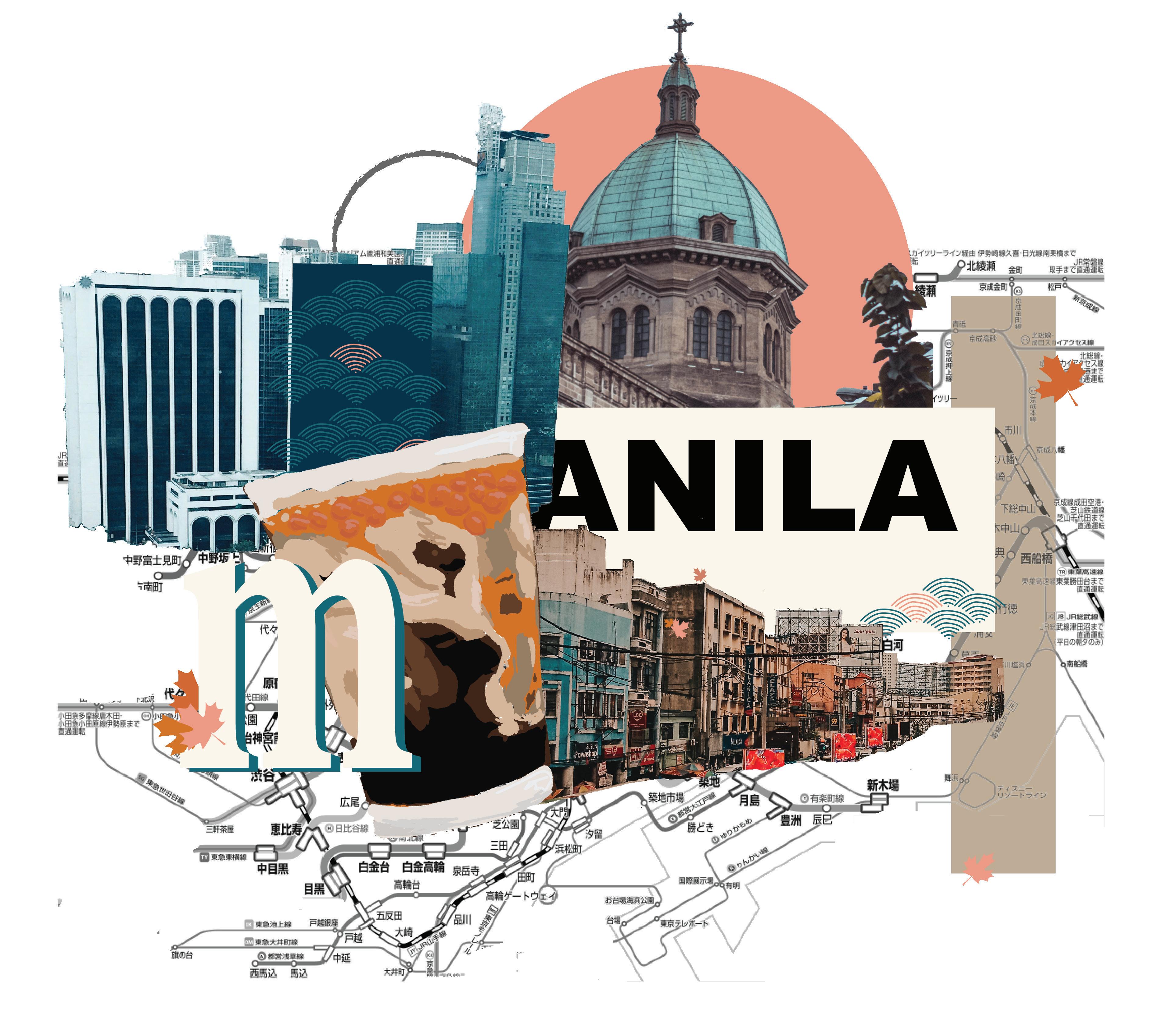
Within the bubble of expat kids, Interna tional Day was known to be one of the most exciting days of the year. We could forgo our uniform at my school in Manila and instead wear our home country’s national costume. Kids would come to school in their hanbok, baro’t saya, sari or cowboy boots, and a cultur al carnival emerged in our school playground. I would alternate between a red Roots Canada shirt and a Japanese yukata each year as an homage to my parents’ cultures and my pass
port countries. But still, whenever I visited Japan or Canada to see family, it always felt like a vacation rather than a homecoming.
Despite being able to speak Japanese and navigate Tokyo’s complex subway system, after passing the foreigners in the Japanese passport-only line at immigration, I feel like a tourist myself. Shop owners and mall assis tants were always surprised when I responded to their broken English with “nihongo de daijoubu desu” (Japanese is okay).
Growing up with people from all over the world, I find myself to be adaptable in terms of respecting and following the social norms in a new situation, but there are some things that are impossible to know without complete immersion.
When I was around 11, I was having a con versation with my grandmother about rice crack ers when I referred to her as anata, a pronoun I didn’t know at the time is polite when you use it for people whom you don’t know but extremely rude if you use it for someone you do know. This
was the first time I had heard my grandmother yell. I waited in tears for my mom to return from the grocery store in tears explaining, “I don’t know why baba was so mad I thought I was being polite.” Misunderstandings of the culture are what isolate me from “being Japanese.”
I display different personas in different relationships, shapeshifting in what seems like a fruitless attempt to stitch together pieces of my identity. Constantly trying to fit in with my surroundings, trying to find a place to make me feel, even temporarily, at home. The one place I didn’t have to try to fit in was in the internation al communities of expats I grew up in because our differences were paradoxically unifying. I felt at home not when the people around me ethnically resembled me but when we shared experiences. In many cases, it was easier to find similarities to people from countries I had never imagined visiting than to people whose lives seemed more similar to my own at first glance. U
 by MAHIN E ALAM
by MAHIN E ALAM
The UBC Wall Opera Project is explor ing how opera changes the brain.
At any given moment on stage, an opera singer may be making a dozen different split-second decisions. They’re singing, acting, navigating the set, work ing with an orchestra and engaging an audience — all while wearing costumes that can weigh up to 45 pounds.
The Wall Opera Project is exploring how rigorous opera training sculpts the brain. Through physiological and psychological evaluations, researchers hope to demonstrate the effects of op era training on memory and executive function.
At the beginning of the academic year, study participants — including opera singers, actors and athletes — un dergo a MRI scan and full assessment of working memory and educational
abilities. After going through a year of training, researchers then reimage and reassess neuropsychological function.
This interdisciplinary initiative requires efforts from a diverse team of researchers, including Nancy Hermis ton, voice and opera divisions director at UBC School of Music, Dr. Lara Boyd of the Brain Behaviour Laboratory, Dr. Janet Werker, a psychology professor, as well as post-doctoral fellows Anja-Xia oxing Cui and Negin Motamed Yeganeh.
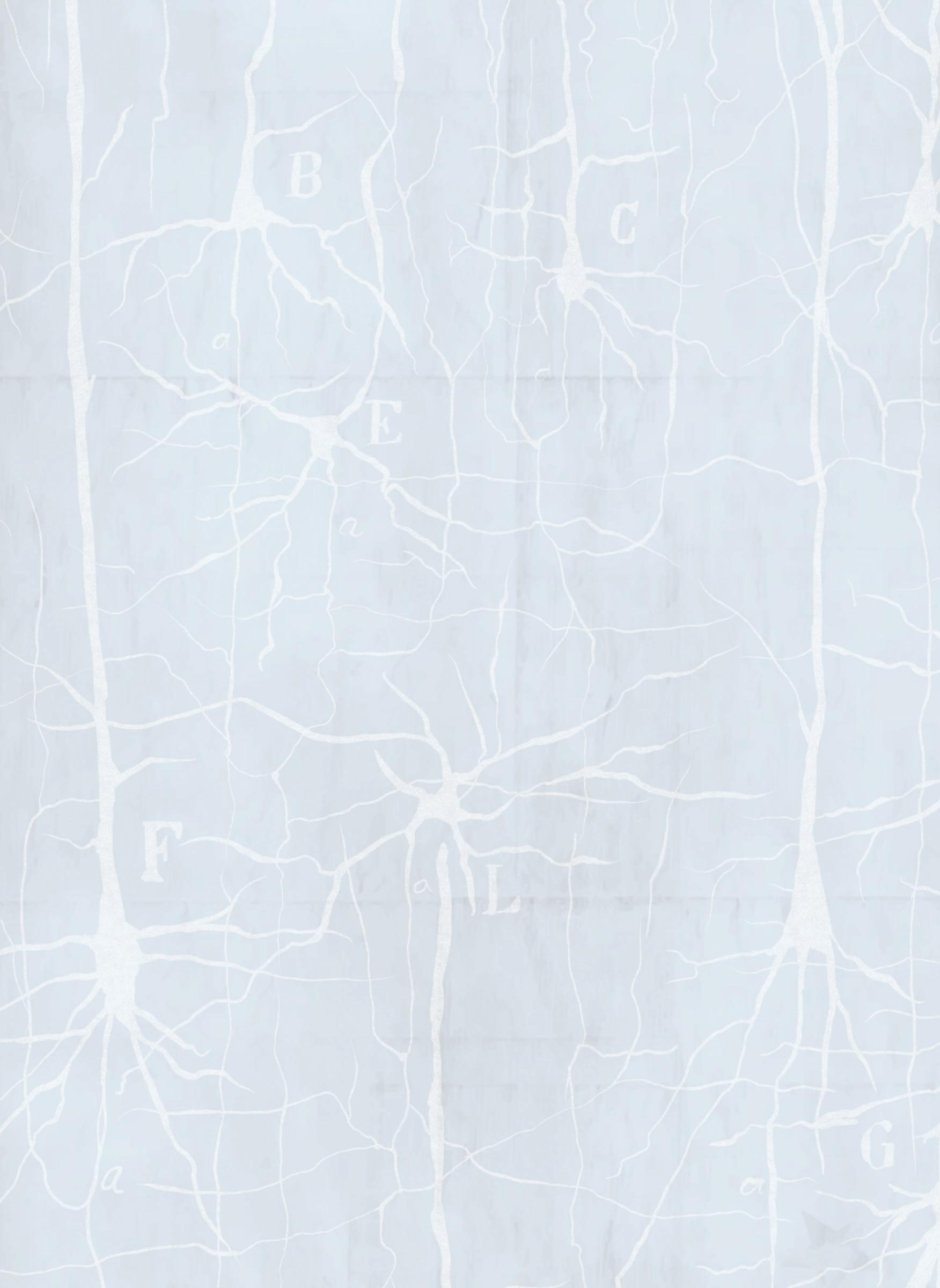

Werker focuses on the language acquisition element of opera. Singers are required to understand what they are singing about, as well as what others onstage are saying, to act out a story.
Performing in French, German and Ital ian (and occasionally Russian, Czech and Spanish) promotes an intimate knowledge of each language, although
rarely complete fluency.
Before being picked up by the Peter Wall Institute for Advanced Stud ies, Hermiston has tried to kickstart research on the intersection between op era and neuroscience for nearly 16 years.
Boyd pointed out that a psychologist, a neuroscientist and a music professor is a very unusual combination of principal investigators for a study. She said it’s very fortunate that they were able to find support for this type of work, and that it will be difficult to do again.
Artists often suffer because “re search agencies that give out money want to see graphs, they want to see charts, they want to see results,” ac cording to Hermiston. “And what can we say? We can say our audience was absolutely silent at the end of a perfor mance because they were so moved …
But how do you measure that?” Herm iston said.
“At its very basic level,” said Boyd, “[the study] just gives us a much better appreciation for the importance of the arts, in society and in our student body.” On both a personal and institutional level, research supporting the value of music may inform funding decisions in the education system.
After three and a half years of work — COVID-19 restrictions halted live per formances, which caused slight delays in the project – the team looks forward to sifting through one of their first big batches of data in May.
“[Even promising results] certainly won’t show everything,” said Hermiston, “but if it shows that there’s more research to be done, that’s a win there anyway. We want to keep music going.” U
Understanding how brains learn speech requires starting from before babies have even uttered their first word, according to UBC experts.
Dr. Janet Werker, University Killam professor and Canada research chair in psychology, and Dr. Alexis Black, an associate professor in the School of Audiology, research how infants acquire language. Black said a focus on early life is essential as language acquisition requires us to “make the line all the way up [from babies] to adulthood.
Babies interaction with their environ ment slowly helps develop their ability to babble and eventually speak coher ent sentences.
Werker researches infants and their developing communication systems. Her work suggests the brain begins learning language before birth, with newborn brains responding differently to languages they had been surrounded by when in the womb.
According to Werker, the responses differ in monolingual and multilin gual babies. Newborns do not have any sophisticated communication method, but they do have a sucking reflex. Werker’s study found babies suck pacifiers stronger and faster when they hear the same languages they did before birth.
“Monolingual babies … will suck more to listen to the language that they’ve been hearing [in the womb] and bilingual exposed babies will lis
ten more to both of the languages that they heard,” said Werker.
Werker noted speech perception is multi-sensory, saying “babies not only listen to but also watch your mouth when you’re talking, and encode and represent that.”
Black completed her PhD at UBC where she focused on statistical learning which is “the capacity that organisms … have for detecting structure in our environ ment.” Applying this to linguistics, she looked at how babies pick up sound patterns when listening to speech.
One of her studies exposed babies to an artificial language and recorded their brain waves using a electroen cephalogram (EEG).
Neural oscillations initially occured at every input sound but, after about two minutes, “the brain also started having slower oscillations at [multi-syl labic] rates.”
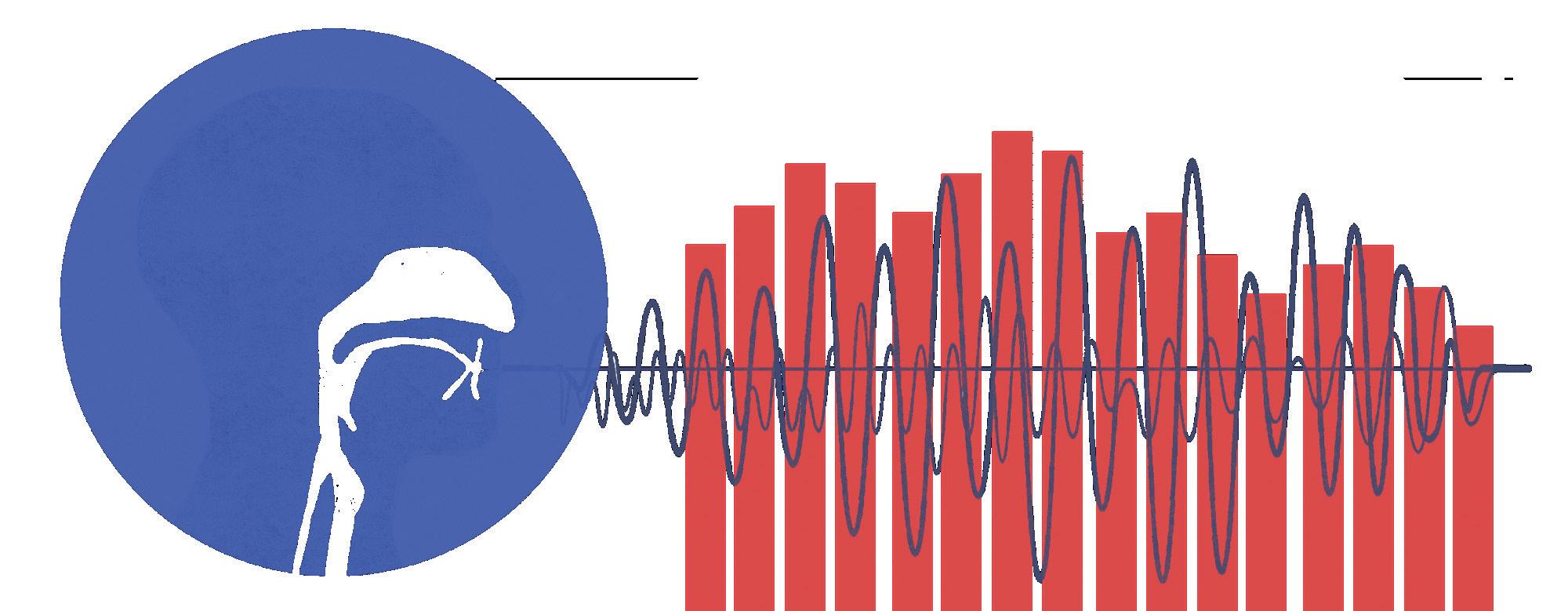
This indicated that babies were starting to find implicit patterns and shift from perceiving isolated syllables to recognizing words.
Two major brain areas are implicated in language processing: Broca’s area is associated with speech production and Wernicke’s area is responsible for lan guage development and comprehension. Connections between these regions strengthen over time, helping children develop language acquisition abilities.
Black uses tech-savvy methods to
understand what goes on in the brain as babies learn to communicate. She primarily uses EEGs and functional near-infrared spectroscopy (fNIRS) to ask different questions about how the brain acquires language.
Werker explained that fNIRS is “the least invasive and the safest and easiest to use with infants.” The fNIRS gives insight into brain activity by detecting the absorption of near-infrared light by hemoglobin.
These techniques serve a funda mental purpose in helping researchers speak to the complexity of human language.
“I want to understand what our biases and preferences are as a species as soon as we get started, and that’s why I study language, because that’s critical to humans,” said Werker. U
Dr. Nichole Fairbrother’s Perinatal Anxiety Research (PAR) lab is commit ted to improving the mental health and well-being of pregnant and postpartum people through an in-depth investigation of mood and related disorders.
The PAR lab was born from Fair brother’s interest in reproduction and childbirth, and her experience with women’s health gained as a PhD student researching sexual assault-related trauma in female university students. Fairbroth er’s career spans her role as a clinical associate professor in the department of psychiatry, an affiliate investigator at BC Children’s Hospital and a registered psychologist.
Perinatal mood and anxiety disorders may affect around 20 per cent of pregnant and postpartum people, where perinatal refers to the period from pregnancy to shortly after birth. Much of the anxiety perinatal people experience is oriented around their infant, said Fairbrother.
“Will my baby be okay? Will my preg nancy go okay? Once the baby’s born, will they be safe?” she said.
One in five new mothers experiences one or more anxiety disorders — which Fairbrother highlighted is more than any
other disorder category.
One of the most common concerns reported by new mothers is unwanted, intrusive thoughts about infant-related harm. While half of the participants reported unwanted, intrusive thoughts about harming their baby on purpose and “the vast majority” experience intrusive thoughts about accidental harm, it is still treated as a taboo topic.


“We know that these thoughts [of harming your infant] are not associated with an increased risk of harming your infant. So if we look at two studies, a tiny proportion of people will behave in a physically aggressive way towards their infant, about 2.6-3 per cent,” said Fairbrother.
Speculations have been made about the origins of these thoughts. The PAR lab theorizes that it could be associated with evolution, where people evolved to be hyperaware of threats as new parents and that these thoughts helped them stay alert.
Research from the PAR lab has added to the literature showing an increased risk of developing obsessive-compul sive disorder (OCD) during and after birth. Their work showed new mothers
with OCD were no more likely to report aggressive behaviour toward their babies those people who did not have OCD.
Fairbrother is a certified cognitive behavioral therapist (CBT) and CBT is integral to her treat ment of postpartum anxiety and OCD since new mothers tend to prefer talk therapy to medica tions.
In addition to research on intrusive thoughts, Fairbroth er’s PAR lab is also assessing the accuracy of screening tools for diagnosing OCD in pregnant and postpartum persons, for which she was awarded the Health Professional Inves tigator Award by Michael Smith Health Research BC.
Fairbrother’s lab is striving toward the betterment of maternity care, with consideration given to how her research
As students may find their mood dropping with the temperature, UBC research supports light therapy as a po tential treatment to brighten your winter semester.
The ‘winter blahs’ or ‘winter blues’ are a mild case of seasonal depression that affects up to 15 per cent of Canadi ans. An additional 2–6 per cent experi ence seasonal affective disorder (SAD), a subtype of clinical depression that appears in the fall and winter.
The Mood Disorders Centre at UBC provides light therapy as a safe and ef fective treatment to those with SAD. Dr. Raymond Lam, a professor of psychia try and director of the Mood Disorders Centre, also published evidence that light therapy can treat non-seasonal depression, though this effect was strongest for those also taking anti-de pressants.
Although Vancouver’s heavy rain is commonly associated with dampened spirits, SAD cases are related to latitude rather than local weather patterns, explained Lam.
Those with SAD have a form of jetlag where their internal clock is out of sync with the external environment, accord ing to Lam. This worsens further from the equator due to drastic differences in daytime lengths throughout the year.
Symptoms of SAD appear as days get shorter in the winter and include fatigue, loss of interest and reduced concen tration. Light therapy aims to reset the biological clock and alleviate symptoms by exposing patients to bright artificial light for as little as 30 minutes per day.
A light box used for light therapy provides an intensity of 10,000 lux which is between the outdoor light intensity of a cloudy winter day (3,000 lux) and a sunny summer day (10–50,000 lux). In comparison, the light intensity of a bright office is only around 500 lux.
“People with winter blues often feel improved when they do spend more time outdoors during the winter because even on a dull grey day in Vancouver in the winter, it’s probably at least five or six times as bright as the brightest office lights that you can get,” said Lam.
Although light therapy is an effective treatment, the relation between the biological rhythm shift and its corre sponding antidepressant effects re mains unclear. Researchers have begun investigating the direct effect of light on neurotransmitters like serotonin and dopamine.
Side effects of light therapy are relatively mild with the most common being nausea, dizziness and eye irrita tion. These can be treated by changing the intensity of the light or the location of the lightbox.
Commercial lightboxes can be found
can help inform physicians and health care practitioners.
“We’re in the process of trying to un derstand what do maternity care provid ers know and not know about these kinds of thoughts so that we can develop educa tional materials and training materials for perinatal care providers,” she said.
“Helping people have positive birth experiences really matters.” U
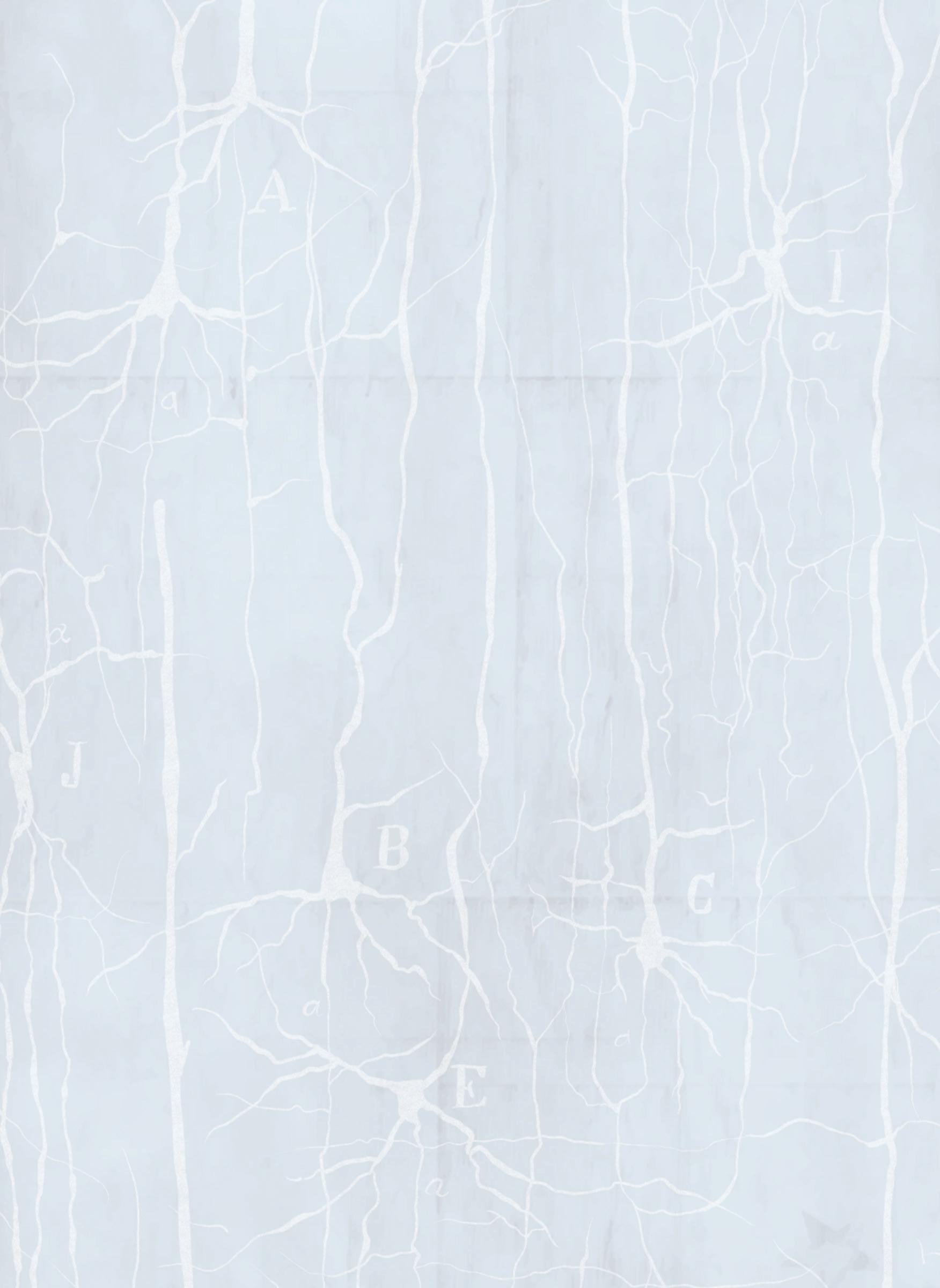
at many retailers, but Lam warns that smaller light boxes may lack the neces sary light intensity to be effective. How ever, people should not treat themselves with light therapy until they are assessed by a qualified health professional.
According to Lam, an early morning pulse of bright light can boast impressive benefits this winter season.
“It really helps people with seasonal depression. It also helps people with winter blues, and so it’s a very simple way to try to improve your energy, fatigue, oversleeping, if you have those problems in the wintertime.” U
of having spinal cord injury,” said Bundon.
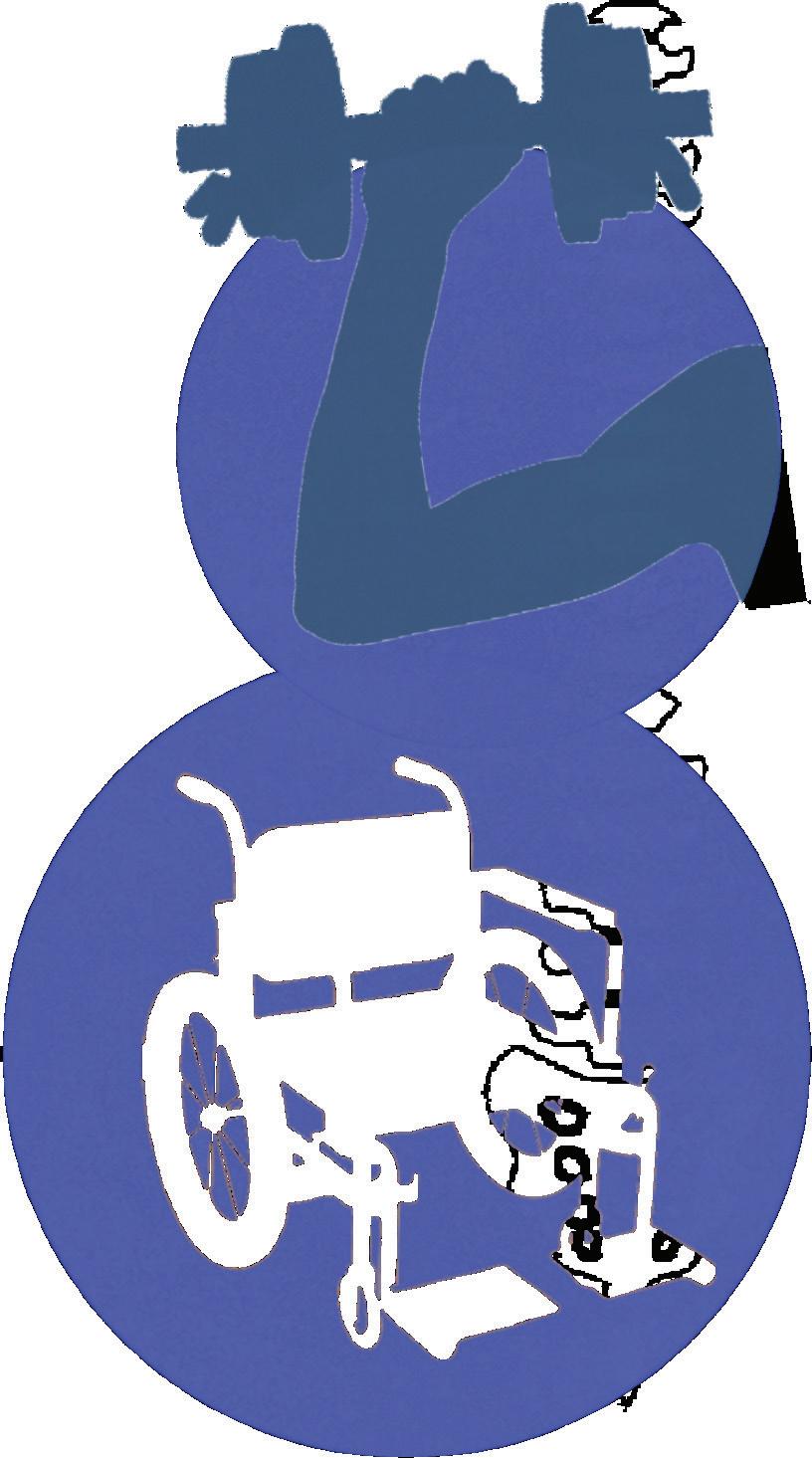
The Yuel Family Physical Activity Re search Centre (PARC) is a community space for people with spinal cord injuries and a hub for UBC research.
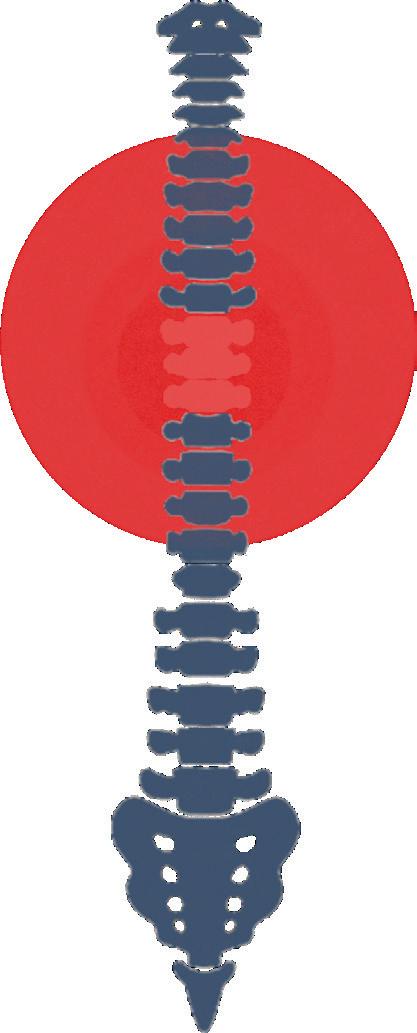
The heart of PARC’s research is a long-term study on how exercise impacts the quality of life of those with spinal cord injuries. For members of the spinal cord injury community, PARC is a place to exercise using high-quality equipment moulded to their needs and foster rela tionships.
“I think what I really have just come to appreciate about PARC is it was started for the research, but it has become a real community centre,” said faculty advisor Dr. Andrea Bundon. She estimates 120150 people have attended PARC — located
at the Blusson Spinal Cord Centre — weekly in the 9 years since it began.
PARC is conducting research on physical exercise and other collaborative projects. Recently, PARC created new ac cessible equipment for wheelchair users, in partnership with spinal cord injury research centre iCORD (its parent insti tute), other UBC groups, SFU, BCIT and community members. PARC equipment is offered in 14 different facilities across BC.
Every year, between 50 and 70 kine siology students volunteer with PARC, through WorkLearn or integrated learn ing. It is a place for students to apply what they have learned in the classroom and gain insight from community members who “get to teach off the lived experiences
During the pandemic, students developed online exercise classes to serve community members who could not attend in person. These classes became so popular that PARC continues to offer them. Bundon said this increased accessi bility, as people who had moved away or could not come to Vancouver are now able to participate virtually.
According to Bundon, PARC has been a boon for the students involved. During the pandemic, students told her they were motivated by knowing they had people relying on them to lead an exercise class along with feeling connected to the par ticipants involved.
PARC has an intake of volunteers at the start of every semester and interested students can check its website. Students are encouraged to visit the facility and learn more.
Bundon said the future of PARC will involve expansions to support other facil ities, which include training, developing and providing accessible equipment, and sharing knowledge.
“We’re really trying to help other places now develop some of this exper tise, or some of the resources so that peo ple with disabilities don’t have to come to PARC. They can go to their community centre, they could go to their local gym and get the same quality that they can get at PARC,” said Bundon.
For Bundon, the dedication of the PARC team and its community members are integral to its success.
“The sort of commitment of everyone to this project in this community is re ally just incredible in my mind [and] the fact that it’s gone so long and has become such a meaningful part of most lives,” she said. U
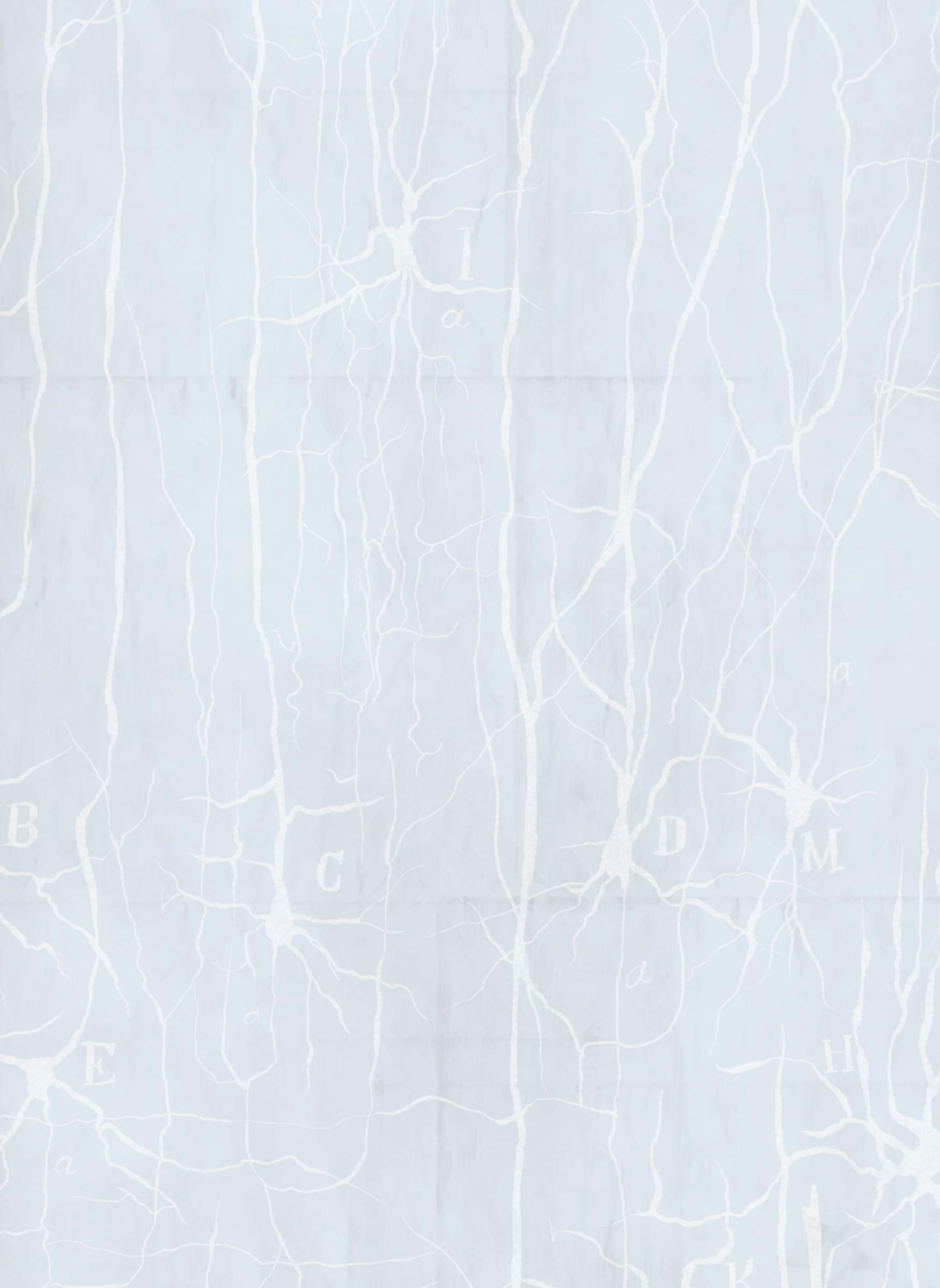 by Maya Levajac
by Maya Levajac
Researchers at UBC are conducting nationally-recognized research on brain health.
Dr. Robin Hsiung, an associate profes sor in the Faculty of Medicine and a staff neurologist at the UBC Hospital Clinic for Alzheimer’s Disease and Related Disorders researches neurodegenerative diseases. Hsiung’s current study aims to predict early dementia risk and provide intervention for cognitive decline.
Neurodegenerative diseases broadly refer to any condition where the ner vous system’s cells deteriorate or stop functioning. Alzheimer’s and dementia are often confused as being the same condition; however, Hsiung emphasized that they are distinct.
“Dementia is an umbrella term for any cognitive decline,” said Hsiung. “Any one who has normal cognition, [and] it’s declined as they age, [has] dementia [and] you have to reach a certain level of decline that is actually bad enough to affect your daily activities.”
Alzheimer’s is the most common type of dementia, making up 60–70 per cent of all cases. Other dementias include Lewy body dementia, which is closely tied to Parkinson’s disease, vascular dementia, caused by multiple small strokes and even forms of dementia caused by infections like HIV.
A decline in short-term memory is characteristic to Alzheimer’s disease and can have multiple detrimental effects,
since short-term memory is a step ping stone to remembering long-term information. Regarding patients, Hsiung explained, “If you cannot even form short-term memory, then they will have difficulty forming any memory.”
Clinical treatments for dementia pa tients are very limited and often address symptoms rather than the root cause.
One method involves increasing neu rotransmitter production — chemicals in the brain for communication between nerve cells — to slow the progression of Alzheimer’s disease. Though elevating neurotransmitter level appears to im prove quality of life, it is not a cure.”
“It helps their memory and attention, but it doesn’t really reverse the disease,” said Hsiung. “It may help the symptoms for a year or two and stabilize them brief ly, but eventually people are still going to
progress.”

Hsiung and his team hope to change the treatment landscape by identifying biomarkers, a measurable biological char acteristic that indicates some medical phenomenon.
“The biomarkers aim to diagnose people before they have full-fledged dementia. We want to diagnose people earlier and earlier,” said Hsiung. Biomark ers can appear long before symptom onset to signal disease and even act as targets for treatment.
PET scans and spinal fluid samples can detect biomarkers like amyloid changes in the brain. These changes can present themselves up to 10 years before the disease’s onset. The role different biomarkers play is hotly debated, making research like Hsiung’s essential.
However, while PET scans and spinal
fluid are helpful, they are not practical for routine clinical use. Hsiung said he is excited to develop accurate blood bio markers in the future — only a blood test would be required, which is accessible and less costly.
Hsiung noted UBC’s research has been put on the international scope by discovering two genes called C9ORF72 and TDP 43. Not much is known about C9ORF72 but it appears to be the most common cause of frontotemporal demen tia. TDP 43 is a common feature of fronto temporal dementia and related disorders.
UBC has provided valuable research and Hsiung’s team is hopeful for the future.
“I think the clinical trial program, our clinic, is so successful because of [Hsiung’s] leadership and his knowledge,” said team member Soo Yung. U
Pain is a complex and subjective phenomenon — a warning alarm that lets a person know there is a threat to their body that must be addressed to maintain health and safety.
In response to noxious stimuli, such as damage to tissues or pain fibres, information is sent through the nervous system to the brain in a process known as nociception. Accord ing to UBC neuroscientists, pain is a complex and individual experience influenced by cognitive and emotional processes.

Researchers like PhD candidate in experimental medicine Jessica Archibald measure pain by assess ing changes in the brain’s electrical activity using electroencephalography (EEG).
The experimental set-up involves placing electrodes on the participants scalp and applying different types of painful stimuli. The wave patterns on the EEG are then matched up to the pariticpants’ rating of the painful stimulus.
“We also use a scale from one to
ten for subjects to measure pain, and the interesting thing is that something that you might give a nine, I may only give a four,” she said. “We see a lot of variability between subjects in terms of [electrical amplitude] even for the same noxious stimulus.”
This means the experience of pain is only partially determined by sensory input.
According to Dr. Kenneth Craig, professor emeritus of psychology at UBC and the director of the BC Pain Research Network, the experience of a painful event is not solely the result of the severity of the physical trauma.
“The remainder [of the pain experi ence] is probably accounted for by how one thinks and feels about it.”
He explained the experience of pain is very individualistic as a large part of it depends on how the per son reacts to the pain. Research has suggested that one’s emotional state
UBC research is contributing to pain management and further under standing the phenomenon of pain.
Archibald’s research is focused on creating objective ways to measure and help people deal with pain. Glutamate, the primary excitatory neurotransmit ter in pain signalling, is central to this goal, as are electrical responses in the brain.

An objective measure for pain could support the evaluation of pain man agement therapies to better support patients and help physicians discern pain experiences in those who have trouble communicating. It can also
help researchers better understand the mechanisms driving pain and support the development of ways to manage it, according to one of Archibald’s papers.
Craig emphasized the importance of complimenting pain management with consideration for the patient as an individual.
“My own preference is to encour age pharmaceutical management, but to also pay attention to the psycholog ical well-being of the individual and their experiences,” said Craig. U
Dr. Annie Ciernia’s lab is studying epi genetics to understand how environmen tal influences impact neurodevelopmen tal disorders, especially autism spectrum disorder.
Her interest in cognitive function and its regulation in autism gradually ex panded to studying genes responsible for particular disorders and their importance in regulating brain function. Ciernia, an assistant professor in the department of biochemistry and molecular biology and a member of the Djavad Mowafaghian Cen tre for Brain Health, shared the nuances of her research into how epigenetics relate to autism spectrum disorder.
Epigenetic mechanisms are based on changes to how genes are expressed or used in the body, without actually changing the DNA sequence itself. These changes are impactful: epigenetics can influence how our cells function, impact the risk of developing diseases like cancer and even explain how experiences can impact physiology across generations.
In neurodevelopmental disorders, epi genetic processes are disrupted. Autism spectrum disorder is a neurodevelopmen tal disorder made distinctive by altered social communication and language, repetitive behaviours and often immune system disruption.
Ciernia’s lab investigates both genetic and environmental autism risk factors and has successfully identified two genes associated with autism. One regulates
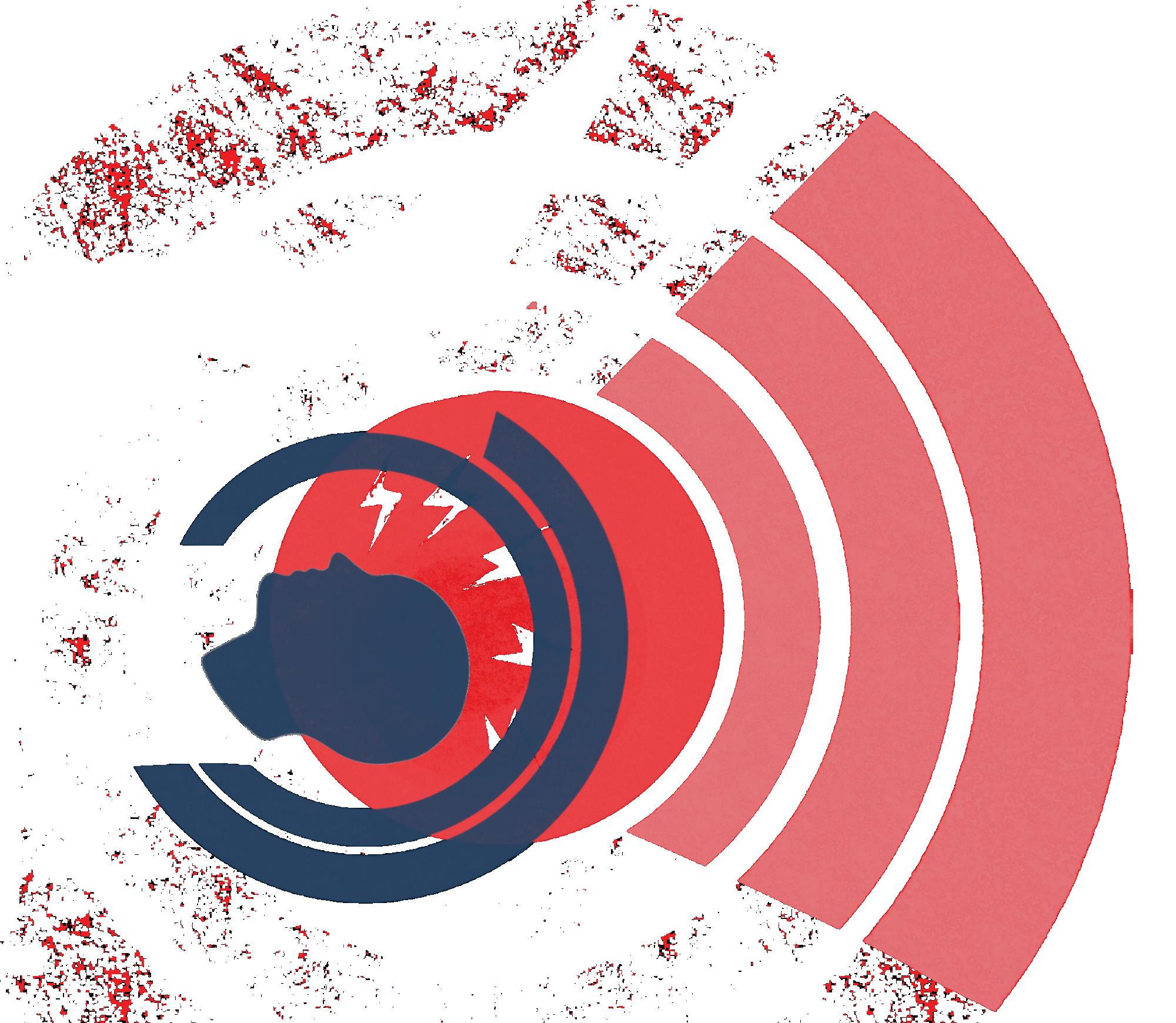
synapses, sites of communication be tween brain cells, and the other controls chromatin, a protein that associates with DNA to help it organize itself and a cru cial epigenetic mechanism.
The Ciernia lab set out to explore how these genes influence autism spectrum disorder using a mouse model. “Mice are very social, just like humans and we can look at how the autism gene mutations alter their social preference,” said Ciernia.
While behaviours indicative of autism can include repetitive self-injury and repetitive play in children, it can be observed as repetitive grooming and obsessive digging in mice.
Dysregulated immune response factors such as inflammation in pregnancy can increase the risk of having a child with a neurodevelopmental disorder, said Ciernia.
To better understand this, the Ciernia lab is looking at resident immune cells in the brain called microglia. Unlike other brain cells, which have a common precursor cell, microglia come from the yolk sac and enter the blood during early embryonic development.
Microglia are crucial in shaping how neurons “talk to each other” across development, according to Ciernia. As mi croglia respond to inflammatory stimuli in the womb and shortly after birth, per turbations during developmental years can result in lifetime impacts.
A study published by Ciernia’s group
looked at microglia in the brain of mice born to mothers with asthma as a model chronic illness. The resulting pups scored high for behaviours associated with autism spectrum disorder, and epigenetic differences were seen in genes linked to inflammation and microglial develop ment. Her team is committed to building upon this research.
Keeping the diversity and needs of chil dren in mind, Ciernia doesn’t believe in curing neurodevelopmental disorders and
emphasized the importance of neurodi versity.
“The problem is not with people with autism. And I think all of us are a little bit different and special and we should rec ognize and celebrate that,” said Ciernia.
The focus is on making things easier for those with autism. She prefers to talk about making environments more amena ble to neurodiverse people.
“My lab focuses on trying to un derstand when brain development is disrupted enough to cause impairments, and how can we help them to adapt and thrive.” U
Neural processes work together to create our idea of everything — a consciousness that perceives reality.
All that we know is based on what our brain allows us to experience. So is our perception of reality fundamentally real or rather, a copy of reality limited by what our nervous system will allow?
From an idealist perspective, philosophy lecturer Dr. Anders Kraal said some may sympathize with the idea that “everything that is called natural sciences is actually about how the human mind encounters the world, rather than simply the world.”
“We don’t have access to [the] external. We only have phenomena as they are experienced by the mind,” said Kraal, referencing an idealist point of view reminiscent of philosophers Immanual Kant and Gottfried Wilhelm Leibniz.
Philosophers have long debated the nature of reality. But thankfully, science can help armchair philosophers and brain aficionados alike better understand these centuries-old questions — and hopefully add some neuroscience to your daily existential crisis.
To understand our reality, it is valuable to parse our knowledge down to exemplary theories and mechanisms driving our perception.
Evolutionary theory can be used to understand why we experience our perceptual world, otherwise known as the umwelt, according to Dr. Lawrence Ward, a professor in psychology, a member of the Djavad Mowafagian Centre for Brain Health and principal investigator of the Psychophysics and Cognitive Neuroscience Laboratory.
The umwelt is determined by our sensory systems and differs between species, explained Ward. It is believed to have been adapted around the specific information an organism needs to survive and thrive in their niches, which refers to the role an organism plays in its environment.
“The [perceivable information] that an animal or a person has are extremely niche relevant and in fact, are quite limited based on the niche,” said Ward.
As we perceive the world, our brain is actually constructing multiple different realities, according to Dr. James Enns, professor in psychology, Distinguished University Scholar at UBC and principal investigator of the UBC Vision Lab.
At any given time the brain is processing two separate visual streams: vision for perception processes information for the purpose of perceiving things, while vision for action processes information for the execution of movements. Evidence also suggests vision for action is important for the overall perception of a scene and the ability to sense where our bodies are in space.
“The brain is constructing multiple
realities, and somehow magically, it coordinates them so that most of the time we have the seamless conscious experience,” Enns said.
These two streams work together to make sense of our visual space, according to Enns. The brain does this without us even realizing it.
According to Dr. Paul Gabias, associate professor in psychology at UBC Okanagan, the brain does not construct reality, but rather extracts reality.
He argues framing reality as something to be extracted places
study for UBC experts.
“I know perception is miraculous, but we have to try to explain things in ways that make it seem perhaps less miraculous,” Gabias said.
Mechanisms governing our perception give insight into how we process reality but fail to address why we experience a conscious understanding of our reality, as opposed to merely responding to it. This is known as the hard problem of consciousness.
“global workspace.” From these intimately connected regions, data is broadcasted to other brain areas and consciousness is born. Global workspace theory assumes sensory input is sequentially converted into conscious output.
In contrast, information integration theory considers consciousness “an intrinsic property of the right kind of cognitive network,” according to an article in Quanta Magazine. Unlike global workspace theory, information integration theory asserts that the network can feed back on itself to drive conscious thoughts in a phenomenon known as “causal power.” The more causal power in a network, the more conscious it supposedly is.
According to Ward, there are a dozen other theories and they are all shrouded in heavy debate. Earlier this year, he published an article in Frontiers in Human Neuroscience where he posited that consciousness is derived from an electromagnetic field generated by the brain’s electrical activity.
The thalamus is also believed to play a crucial role in consciousness, as it acts as a ‘master switch box’ in the brain, where the overwhelming majority of sensory inputs are organized and then sent to the appropriate brain regions for further processing.
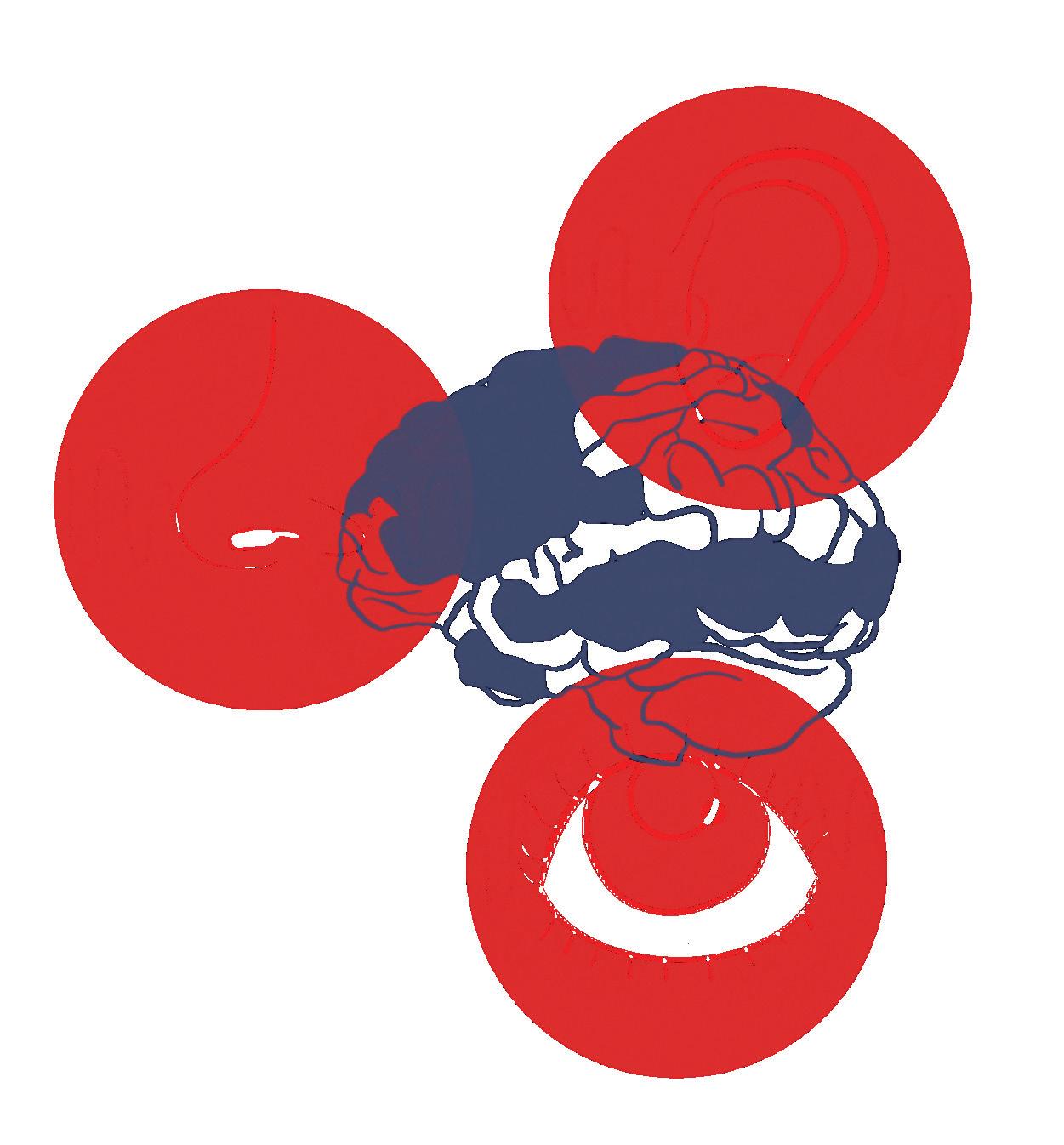
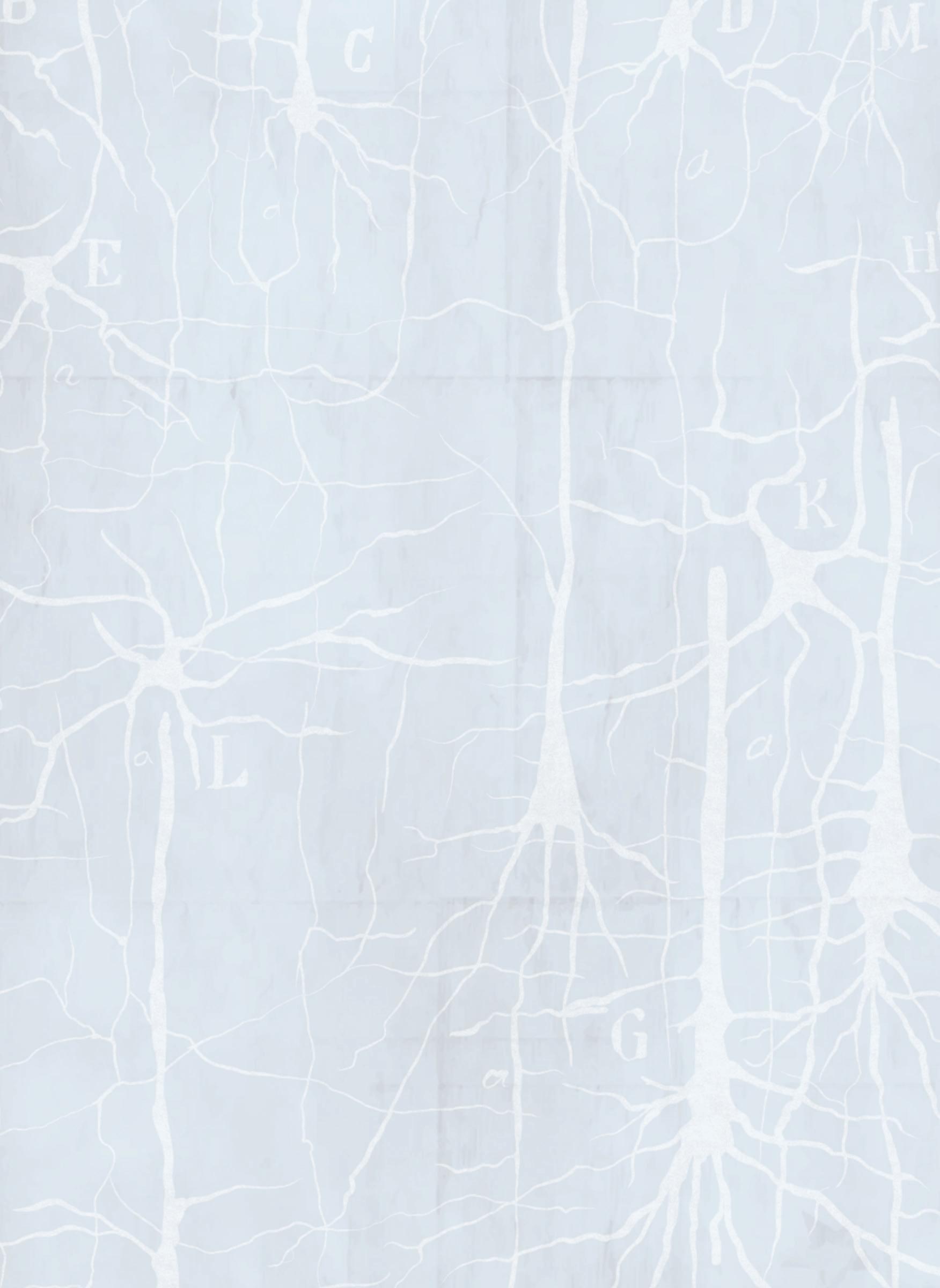
Studies supports connections between the thalamus and the cortex as important for modifying states of consciousness. Beyond the thalamus, functional magnetic resonance imaging has also been used to characterize brain patterns in conscious and minimally conscious people to reveal distinct patterns in the brain for consciousness.
Researchers are continuing to develop strategies to put these different models to the test. But for now, the hard problem of consciousness remains a topic of heated debate.
a greater emphasis on the entire network of perception rather than individual senses or even the brain itself. According to Gabias, without its perceptual systems, the brain “can’t do anything.”
As a blind man and an expert on visual perception, Gabias emphasized the importance of a holistic approach to perception.
“Let’s say blind and sighted people do live in the same world and extract information from that world,” he said. “We really ought to construct a theory of perception that allows us to be able to say that … the information blind people get is equivalent to the information that sighted people get.”
From integrating multiple realities to perceiving information relevant to our niche, the mechanisms and theories driving perception remain an essential area of research and topic of
“None of those [neurological and adaptive] mechanisms entail that we should have experience. They all entail that we can control our behaviour and do the right things to persist in an environment but it doesn’t mean that we have to experience that persisting,” said Ward.
In other words, the hard problem questions the experience of “qualia or phenomenal experiences, such as seeing, hearing, and feeling, and knowing what they are,” according to a review in Neural Networks
There are multiple models of consciousness, but two of the most prominent are the global workspace and information integration theories.
The global workspace theory argues that core subsystems distributed in the brain communicate information with each other in a
It appears that neuroscience might support Kraal’s idealist perspective “where what we could consider empirical reality is actually our mind processing external phenomena,” he said.
Philosophers and scientists will undoubtedly continue to ponder questions about reality for years to come.
In the meantime, Ward offers words of comfort for existentialists to consider — a commentary grounded in an appreciation for interconnectedness, between the circuits in our brains, the niches we occupy and reality itself.
“I would argue reality creates us. Reality is there, and it’s sending information to us constantly about itself — and we are part of it,” he said. U
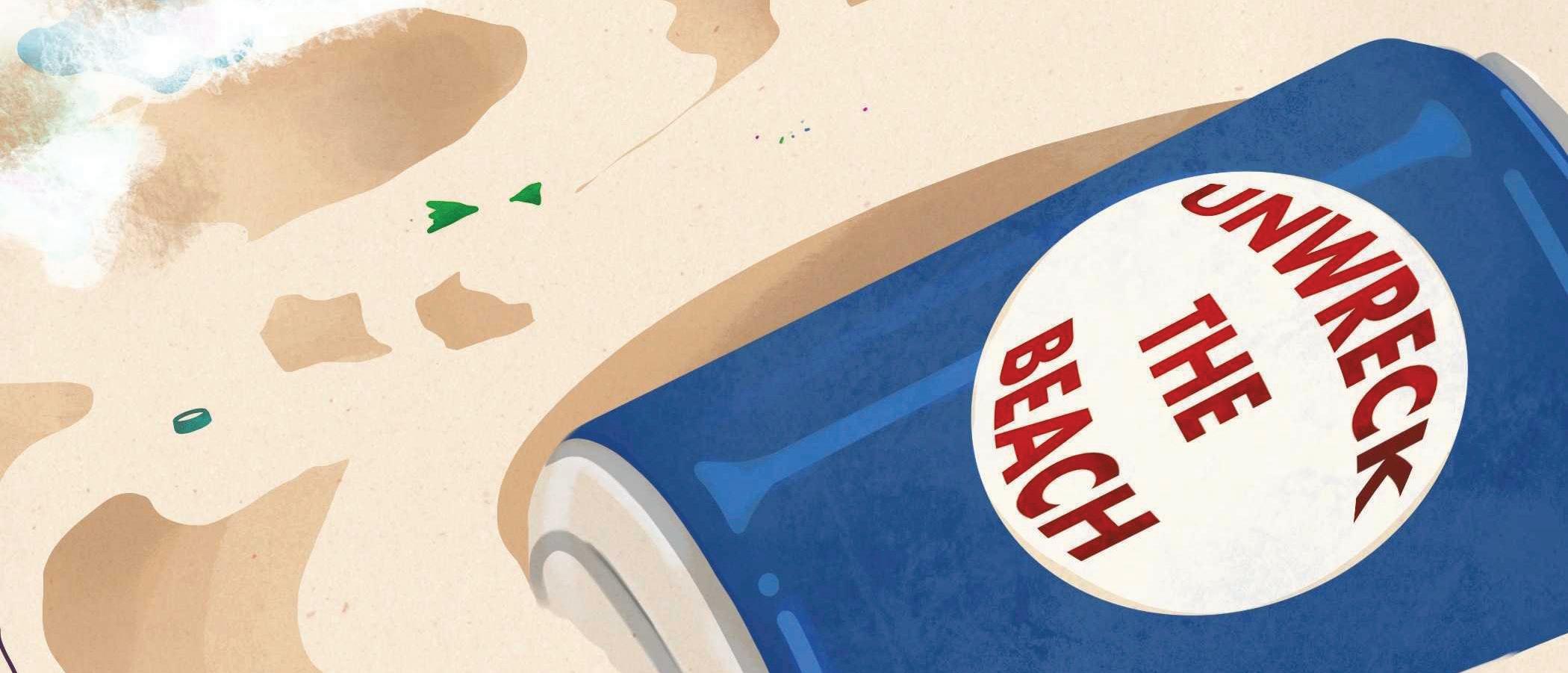 Jasmine Cadeliña Manango Columnist
Jasmine Cadeliña Manango Columnist
The AMS Sustainable Action Plan (ASAP) outlines how your student society will improve its sustain ability going forward, based on the UN Sustainable Development Goals.
The ASAP is divided into six key categories: facilities op erations, business operations, advocacy and leadership, student services, campus coordination and Indigenous coordination.
Besides outlining how the AMS will practice sustainability, it also states the AMS’s commit ment to ethical and sustainable purchasing, including guidelines for licensees, contractors and employers.
The facilities operations cate gory of the ASAP is designed to address how the AMS operates the Nest and highlights its plans when it comes to developing projects and partnerships to create more innovative sustain able infrastructure and reduce its reliance on the UBC district energy grid.
Key aspects of the plan include reducing energy and water usage; reducing overall waste gener ation; reducing waste stream contamination; increasing access to sustainable sources of water; and increasing use of energy from renewable sources.
The ASAP says the AMS has a com mitment to investing and develop ing zero waste programs. Through the ASAP, the AMS plans on devel oping plant-based menus and pro moting OceanWise food products, while reducing the availability of single-use items and increasing the availability of reusable foodware op tions. The AMS also wants to tran sition to local suppliers or suppliers whose collection and transportation methods have a “limited impact on the environment.”
The AMS also trains team members in proper waste sorting procedures, according to the ASAP.
The AMS plans to advocate for
more affordable on-campus student housing and investing in food insecurity-related programs at UBC by using the AMS Housing Service to help students find affordable housing and ensuring that AMS Student Services can support students going through financial hardships, according to the ASAP.
The plan also states the AMS should increase its funding and support for student mental health programs. The ASAP uses a peer-support model to advance student mental health and well being. It also mentions improving existing wellbeing services related to equity and inclusion, women empowerment, healthy masculin ity, sexuality, substance use and student safety.
The ASAP calls for ensuring the
continued operation of the AMS Sexual Assault Support Centre.
ASAP advocacy and leadership-re lated goals include creating more accessible physical activity programming and advocating for more accessible and sustainable transportation options at UBC and around Metro Vancouver.
The ASAP also mentions efforts to continue working on the Dashboard — a software tool used to display sustainability-related metrics at the Nest. The report also states the AMS should create more opportunities for students to provide feedback around sustain
Dear Iman, I’ve been in a major slump since school started. My dorm is a mess, I can’t keep track of assignments, I never see my friends and well, I just can’t seem to get out of my slump. How can I become productive again?

We’re in the final stretch of the semester and oh boy, is it hard. Homesickness is starting to hit and you’re just starting to realize that the elective you took for an easy A is dragging your average way down. It’s slump city.
Slumps happen and it’s good that you’re catching it as it comes on, instead of trying to suppress it. I think the best way to overcome a slump is to recognize you need to rest, and then plan how you’ll tackle your ever-expanding to-do list. I know, it’s no fun, but you’ve gotta do it.
So, step one: rest. Sleep, stay hydrated, chill, hangout, take time to slow down. This can be especially hard when school deadlines are piling up, but even a night or two of rest will do you good. Burnout is real and you might feel guilty or lazy for taking a break while everyone else is supposedly grinding it out, but hear me out — people need to take breaks and not everyone is 100 per cent productive 100 per cent of the time.
It’s slump city.
I also like to talk to my friends. They’ll understand where you’re coming from, and seeing that you’re not the only person having an absolute dogshit time makes you feel better. I mean, it makes me feel better at least. Having a bad time while your friends are is solidarity, camaraderie and friend
ship at its finest.
After resting, I write down all my tasks — assignments, articles I’m working on, household tasks that need to be completed, gro ceries I need to buy — and slowly, I get myself to finish all of them. I like lists because you can see things getting crossed off. It’s
motivational that way. And typi cally, once this list is completely checked off, I feel more comfort able with taking on new tasks, or even relaxing more (which you should be doing anyway!) because I’ve tackled all the things I needed to get done.
But, besides recognizing you’re
ability.
The AMS also wants to work toward increasing the number of applications received for the Sus tainable Projects Fund and support both AMS and non-AMS student groups in sustainability efforts.
The document also says the AMS should continue its formal partnerships with UBC’s Social Ecological Economic Development Studies (SEEDS) and Sustainability Ambassadors programs. Further collaboration with the University Sustainability Initiative and UBC Campus and Community Planning was also encouraged.
The Indigenous coordina tion section of the ASAP was not included in the final report. The AMS stated that it would work with the AMS Indigenous Com mittee to create the Indigenous coordination section together to include at a later date.
The ASAP also mentioned work ing with UBC to create more programming centered on sustain ability. The plan also emphasized working closely with student groups like the Student Environ ment Center and the Climate Hub.
The ASAPs next review will occur in 2023. U
Unwreck the Beach is The Ubyssey ’s sustainability col umn. Send pitches or topics you’d like covered to sustainability@ ubyssey ca.
in a slump, it’s also important to recognize why you’re there. I might not know everything, I know a few things for sure, like if you’re working yourself to the bone to get that A+, you won’t be able to experience all the ‘univer sity experience’ things people rave about. Yeah, yeah I get it — you’re here for the degree. But having fun and making memories matter, as cheesy as that sounds.
It’s also important to know when to go to others for help. Your professors and TAs are there to support you with school and your family and friends are there to support you at home. But, some times a slump isn’t just a thing to get over, rather, it’s something to talk to a mental health profes sional about. There is no shame in reaching out to others for support and, if in doubt, you should.
So, take that nap and rest. You can start to tackle your slump once you wake up.
You’re doing great. Keep it up! U
The author of this column are not mental health professionals. If you need additional support, please contact Student Health Services, the Sexual Assault Support Centre and/or the Wellness Centre. In case of an emergency, call 911.
Need advice? Send your questions, queries or problems to advice@ ubyssey.ca, or submit anonymously at ubyssey.ca/advice!
 Polina Petlitsyna Contributor
Polina Petlitsyna Contributor

UBC has just announced new changes to its academic policies. So, we broke them down.
1. If the professor is not here in 15 minutes, you are definitely most certainly allowed to leave.
2. If you make eye contact with an engineering physics student, you will have four years of bad luck (in love).
3. To get extra credit for a forestry class, students must blaze it with the professors. Choice of rolling paper must align with the syllabus.
4. Pharmacy students can get extra credit by creating drugs for forestry students to... you get the point.
5. A Sauder degree comes with a free LinkedIn Premium ac count and a pack of unscented moisturizer (because snake). Why a pack? To share with your network of course!
6. Students double majoring in en vironmental science and philos ophy get free unlimited access to UBC’s Existential Crisis Fund.
7. First-year science students can get an extra 0.5 points in their classes, provided they wanted to study medicine ever since their hamster got asthma in fourth grade.
8. For those who are on the wait ing list for a required kinesi ology class, don’t wait. Bring
your barbell weights to the professor’s office and loudly lift 200 lbs until they lose it and let you into the course.
9. Psychology students are en couraged to make use of their department’s resources.
10. It’s mandatory for AMS exec utives to take the stairs twice a day to avoid student journalists in the elevators.
11. Graduating Faculty of Arts stu dents are allowed to miss three classes a term to cry inside of a thrift store dressing room. Why? Because capitalism.
12. English majors are allowed to swear (in Old English) if the Starbucks barista spelled their name wrong. They’re also al lowed to quote essays from 12th grade to fill the void. Why reach for the tissues when readings are right there on the table?
13. UBC increases eye care coverage exponentially for students in the department of computer science the day before their finals and during virtual dates with their bots.
14. LFS students officially complete their degree once they can
explain what LFS stands for (no really, what is this faculty?). I love land and food!
15. Music students can substitute their required performance courses with a karaoke-whereno-one-can-sing-but-them. Tonight, we all hit that Ariana Grande whistle note, right? (Note: The rhyme wasn’t inten tional and poetry is a disease.)
16. Only in education classes can students deconstruct the sylla bus (and the terrified non-ten ured prof) in order to succeed.
17. Political science orientation
packages come with a free Ma chiavelli poster, a fake plant and a pre-law society flyer? Huh? What’s that? How did that get here?
18. After every finals season, gender, race, sexuality and social justice students can apply for their pro gram’s get-more-hand-tattoosand-cartilage-piercings fund. Don’t furrow your bleached brows at me! It’s a real rule!
19. After 90 credits, cognitive systems students are allowed to adopt an AI robot pet and lose sight of all reality. (2050 is around the corner, I can shmell it!)
20. Math students are allowed to... I’m sorry... deserve to... live a happy life.
21. A theology student’s degree is not complete until they have invited at least one stranger to their uncomfortably-welcoming church club. I’ve heard of the banana’d crew, but have you ever been bible’d?
22. In order to grant academic extension in the Faculty of Arts, students must present the following: lactose intolerance, your mom’s jeans and an obses sion with Koerner’s Pub. Stop waving your well-manicured hands at me and go take your melatonin! U
The Dingbat is The Ubyssey’s hu mour section. Send pitches and com pleted pieces to blog@ubyssey.ca
On October 19, 20 bunnies were seen hopping down Main Mall. Now, a month later, this number has increased to 100 and is esti mated to reach 300 trillion by the end of the semester.
The newly-established UBC bunny population has created cha os on campus — jumping in front of bikers, stealing people’s salads mid-forkful and pooping all over the sidewalk. The infestation has cost UBC grounds maintenance millions of dollars in equipment replacements due to accidentally running over bunnies.
The student behind the crime was finally caught after MATH 420 midterms were marked, and their Friday night plans were scribbled on the back of an exam:
1. Eat cheetos for dinner
2. Cry for 3 hours, 33 minutes about a failed math exam
3. Bus to Jericho Beach to kid nap bunnies and release them on Main Mall
When asked to comment on why they did it, the rabbitology student, who wishes to remain anonymous, claims it was for the benefit of UBC maintenance and student wellness.
“The idea came to me like a blessing. After I was waitlisted for
The infestation has cost UBC grounds maintenance millions of dollars.
the bunny therapy workshop, I just felt empty, like there was this void in my life,” they said. “Then I realized, it’s not like there’s a shortage of bunnies in Vancouver, right?”
At this point of the interview, the student picked up a fluffle (I kid you not, this is the word for
a group of bunnies) and passion ately cried, “Bunnies are basically a synonym for free lawn mowing and fertilizing. Not to mention the much-needed therapy! Wild bun nies don’t require pre-registration or waitlists!”
Many other students on cam pus seem to agree.
Ninety per cent of the student body reported an improvement in mental health since the Main Mall Bunny Arrival (the other 10 per cent reported being trauma tized after seeing Kip the Coyote munching happily on the bunnies).
However, the UBC biology de partment is less than convinced.
“At UBC, we only accept the best and brightest,” said Dr. Tree McGregor, associate professor of the Biodiversity Research Centre. “I’m shocked that anyone would be so stupid as to release wild bun nies, thereby creating a founder effect situation and establishing an invasive population.”
McGregor is currently petition ing UBC to make first-year ecology classes mandatory for all students to prevent such an incident from occurring again.
Meanwhile, the campus coy otes have been careful to keep quiet. Or maybe Kip is just a bit too busy with his ever-expanding family of 500. At the rate that this is going, the legendary Kipthe Coyote Instagram may need to be renamed to KiptheWolfpack. (Dr. McGregor would like to comment that a group of coyotes are not the same as a wolf pack to which I reply, “Never trust an academic!”)
The Main Mall bunnies are only growing in numbers, much to the indignation of UBC Athlet ics. A recent change.org petition is calling for UBC’s mascot to be changed into the ‘Thunderbun nies,’ leaving the newly printed T-Bird jerseys useless. U
The Dingbat is The Ubyssey’s hu mour section. Send pitches and com pleted pieces to blog@ubyssey.ca
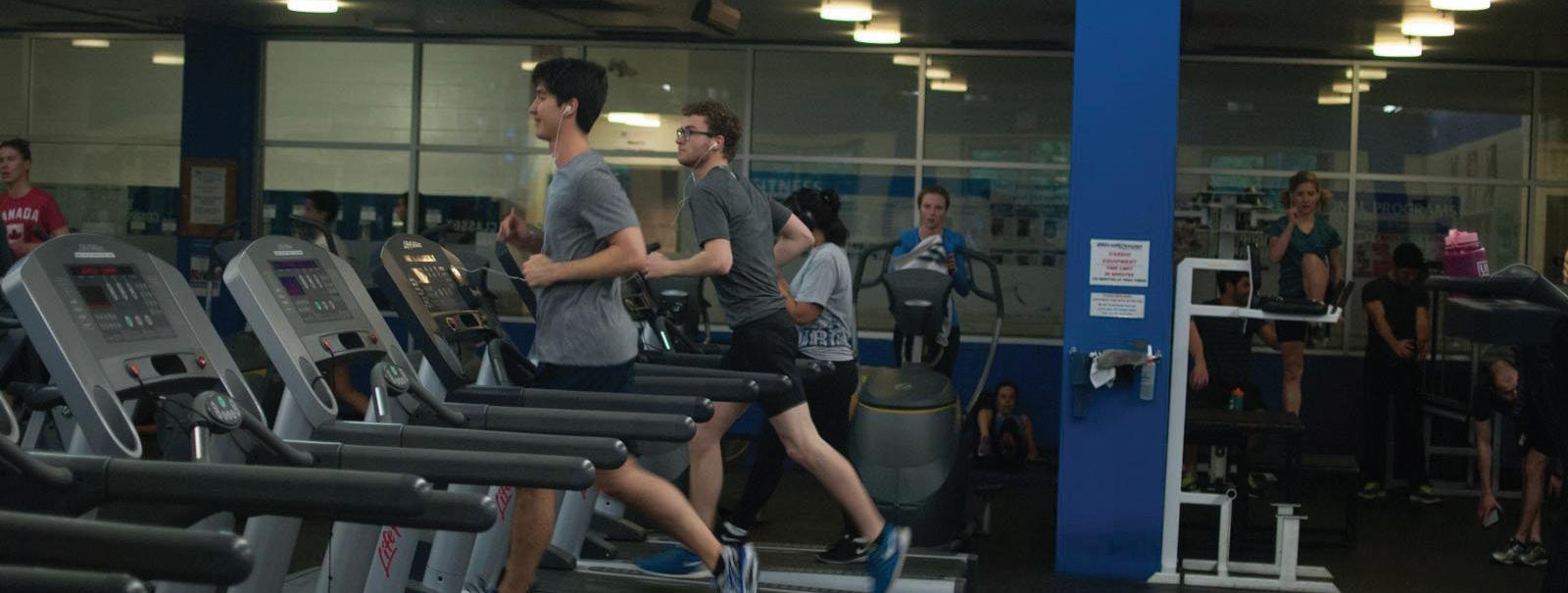 Jessica Norn Contributor
Jessica Norn Contributor
I’m deep into midterms and all I want to do is curl up under my blankets with my ramen and Taylor Swift’s Midnights. But, there’s always a sneaking little reminder working its way into my head. I forgot to workout.
This thought never leaves me, especially since I made that same old New Year’s resolution back in January.
“2022 is my year,” I told every one. “This year, I will not turn into another reclusive bed-gremlin. Just you watch, this year I will finally have my shit together.”
Well trust me, my shit was nowhere to be found (except the toilet, but you know!).
No. Between all my classes and the barren remains of what was once described as “a social life,” I managed to curate the most time-efficient way to stay active while saving time.
Oh yes, I’m saving minutes and money while building muscle.
The daily routine starts with the usual: sleeping in. Now, it might feel counterintuitive, but trust me here.
I just keep hitting snooze until I’m running at the risk of missing class. Then, I have to jump out of bed, and race around the room, kicking off this cardio-intense daily
IS IN GATORADE //My shit was nowhere to be found (except the toilet)!
routine. I make sure to leave every thing dumped on the ground from the night before; bending down to pick everything up is a nice little trick to activate those abs.
Then I just keep that heart rate up by running for the bus, and when I hop on, I’ve already got that “healthy glow” and rosy cheeks. It’s the perfect life hack to hide that dead look from the midterm grind.
Now, since I’m always on the last bus I can take to still get to class, it’s another sprint across campus to make it on time.
The best part? I get in my arm workout at the same time. Just ig nore your chiropractor and buy all physical copies of your textbooks and carry them around wherever you go. It tones the back without any extra time.
Next, I keep up with all that car dio by scheduling classes back-toback on opposite sides of campus, so it’s another run.
After my morning classes, I’ve got a few hours to spare, so I grab a much-needed lunch before moving on to the next part of this full-body workout.
Simply head on over to the library and prepare to work those luscious sweatpant-wrapped legs, as you walk the stairs up to the top floor to study for the next few hours before your next class.
And if I’m really feeling it, I like to target my glutes by doing lunges up the stairs to really plump that rear end.
But of course, once this long and active day is finally over, I like to finish it off with a final energizing cardio session by running for the bus to get home and getting that mental espresso shot to finish up
readings and assignments.
My friends might say I’m “losing it” and those people in the library might say that I’m “that weird person” they “should call se curity on” when they see me using the library’s special collection of 17th-century anatomy encylopedias as weights to get those reps, but just wait. Because this year, I’m sticking to my goals.
This is my year. U
The Dingbat is The Ubyssey’s hu mour section. Send pitches and com pleted pieces to blog@ubyssey.ca
We’re at that point in the semester when everyone around you is sniffling, UberEats has become your best friend and you’re falling behind in at least one course (or let’s be honest, all of your courses). If you’re still going to class, you inspire me to be a better version of myself everyday. Except, I choose to do nothing with this inspiration whatsoever.
But on the off-chance that you are also just a burnt-out human being whose middle name is procrastination, this is for you. Because honestly, no matter how much you say “this week is really crazy for me! But, I can do it.” you know it’s about damn time to ask for an extension.

Got a paper whose prompt immediately gave you mental di arrhea? Or perhaps an assignment that seems to suck the soul right out of you the minute you open the tab? Don’t worry, we’ve got you covered with these foolproof ex cuses to get you out of doing your work (for now).
“I WAS PERSONALLY VICTIM IZED BY KIP THE COYOTE.”
I know I’m slandering my favourite campus canine by suggesting this one, but for the greater good of
I was personally victimized by Kip the Coyote.
humanity I had to.
The UBC equivalent of “my dog ate my homework,” this excuse is foolproof for a couple of reasons.
Firstly, how the fuck is your professor going to verify that you were, indeed, attacked/hunted/ stalked by a coyote?
Secondly, your professor is
probably just as scared of coyotes as you are, so by the time they even read the first line of your extension email, they’ll be on their knees trying to give it to you.
“MERCURY IS IN RETROGRADE.”
I’m willing to bet money on the
fact that there are definitely some professors out here who are secretly astrology hoes. I have a sneaking suspicion that many exist in the English department, and al most all of them must congregate outside Buchanan Tower every full moon.
If you know for sure that your
professor is one of these yassified horoscope fanatics, this is the best excuse to use. Nobody would dare to leave their house during retrograde, so what’s a pesky little assignment?
Bonus points if you manage to say “mercury is in retrograde” and not “in gatorade” (Yes, I spend too much time on TikTok).
This one’s for my pals who have class in West Mall Swing Space, or just generally find themselves strolling around the Ponderosa/ Marine area.
Truly, I feel for you. Any aes thete could prove (in under 2 sec onds) how dirty Cumbria (yeah... that’s what the yellow things are called) did the art world when it found itself plopped on our cam pus. The victims? All the people who have to walk past it every day.
If I were your professor, rest as sured you’d have an extension not just for this paper, but I’d personal ly write hate mail to the university for putting this unit up in the first place. If your prof actually loves you, they would do the same. U
The Dingbat is The Ubyssey’s hu mour section. Send pitches and com pleted pieces to blog@ubyssey.ca
“THE


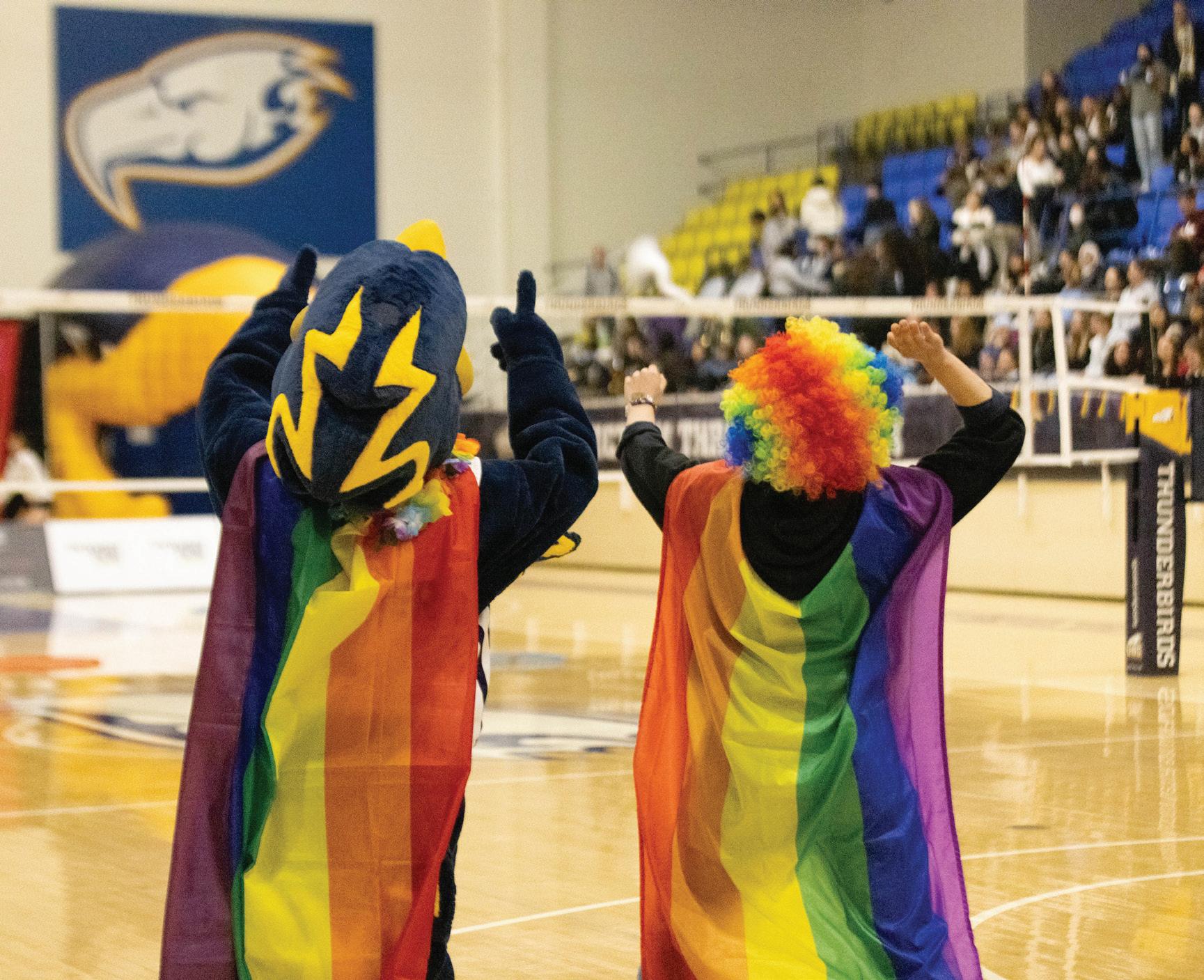 Words by Shruthi Chockkalingam Photos by Miriam Celebiler and Isabella Falsetti
Words by Shruthi Chockkalingam Photos by Miriam Celebiler and Isabella Falsetti
Rainbow flags hung all around War Memori al Gym as Thunder and DJ Nasri mixes greet ed fans at UBC Volleyball’s fifth annual Pride Night on Friday. The event started in 2018 as a partnership between UBC Volleyball and the Vancouver Gay Volleyball Association and has been going strong ever since.
This year’s Pride Night, supporting the non-profit organization Qmunity, was hosted in collaboration with UBC’s Pride Collective.
“The Pride Collective is an organization that represents all Queer students on cam pus,” explained member Isabelle Rowe-Cod
ner. Standing at her booth in the lobby along with other members of the group, she welcomed attendees with assorted pronoun buttons and a tri-fold display detailing how to get connected to the organization.
“I think events like this are really good for visibility of queerness on campus … it’s very important that every person on campus is aware of the fact that queerness exists all around them and Queer people feel safe in their day-to-day lives,” she added.
Puffy jackets and toques were the out fits of choice for the people pouring into the
building as the night kicked off. The cold November weather didn’t dampen creativity, as fans worked the Pride theme into their outfits with rainbow flower necklaces, wigs and even suspenders.

“We used dry erase markers, face paint, anything,” said Marley Hearn, a student in the stands.
Inside the gym, there was no shortage of excitement. The stellar play by the women’s volleyball team as they shut out the Univer sity of Alberta Golden Bears 3–0, and the thrilling, hard-fought men’s match up that
resulted in a 3–1 loss for the T-Birds, was only the beginning of the story.
The Thunderbird Marching Band supplied tunes to increase the energy, the dance team showed off some moves, and there were plenty of goodies to go around. Members of the crowd jockeyed for t-shirts thrown into the stands, and a select few competed in volleyball serving contests during the set breaks for a chance to win lululemon gift cards.
Though the event stood out in terms of enter tainment value alone, there was a deeper reason behind some fans’ participation. Kate White, a mom, brought her family along to enjoy the festivities.
“Why we wanted to come tonight is, we actu ally brought our daughters … I think it’s nice for them to come out and see what’s going on and be exposed to different things.”
As the audience cheered them on, the wom en’s volleyball team put on a show, winning set after set. Lucy Borowski impressed with 14 digs and 15 kills in the victory, and Elise Petit made her mark with 5 aces and 9 kills. “[The game] was a lot of fun, big crowd, definitely,” said Borowski.
With the win, the T-Birds improved to 7–0 on the Canada West season.
Libero Kacey Jost elaborated on what Pride looks like within the context of the volleyball
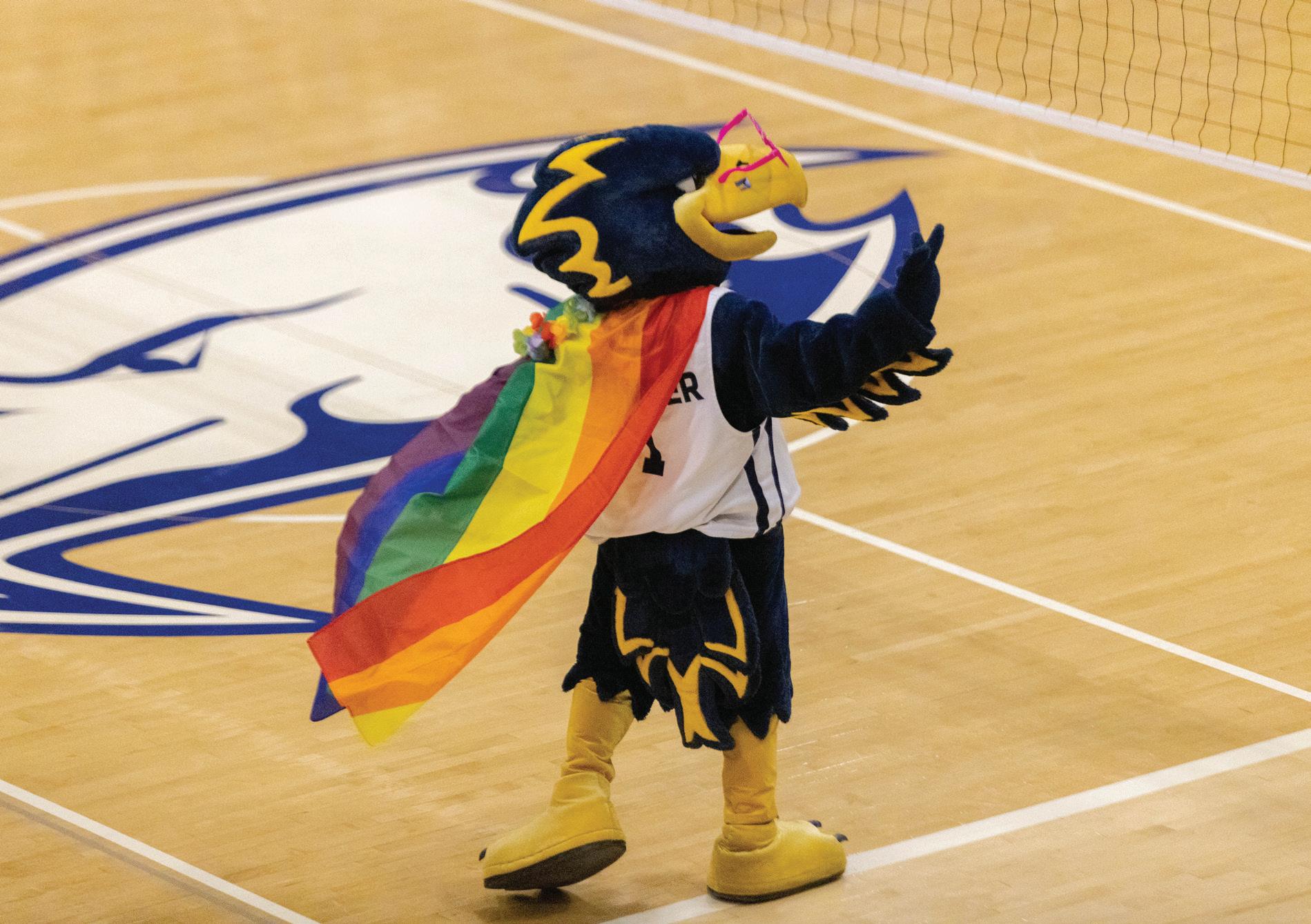
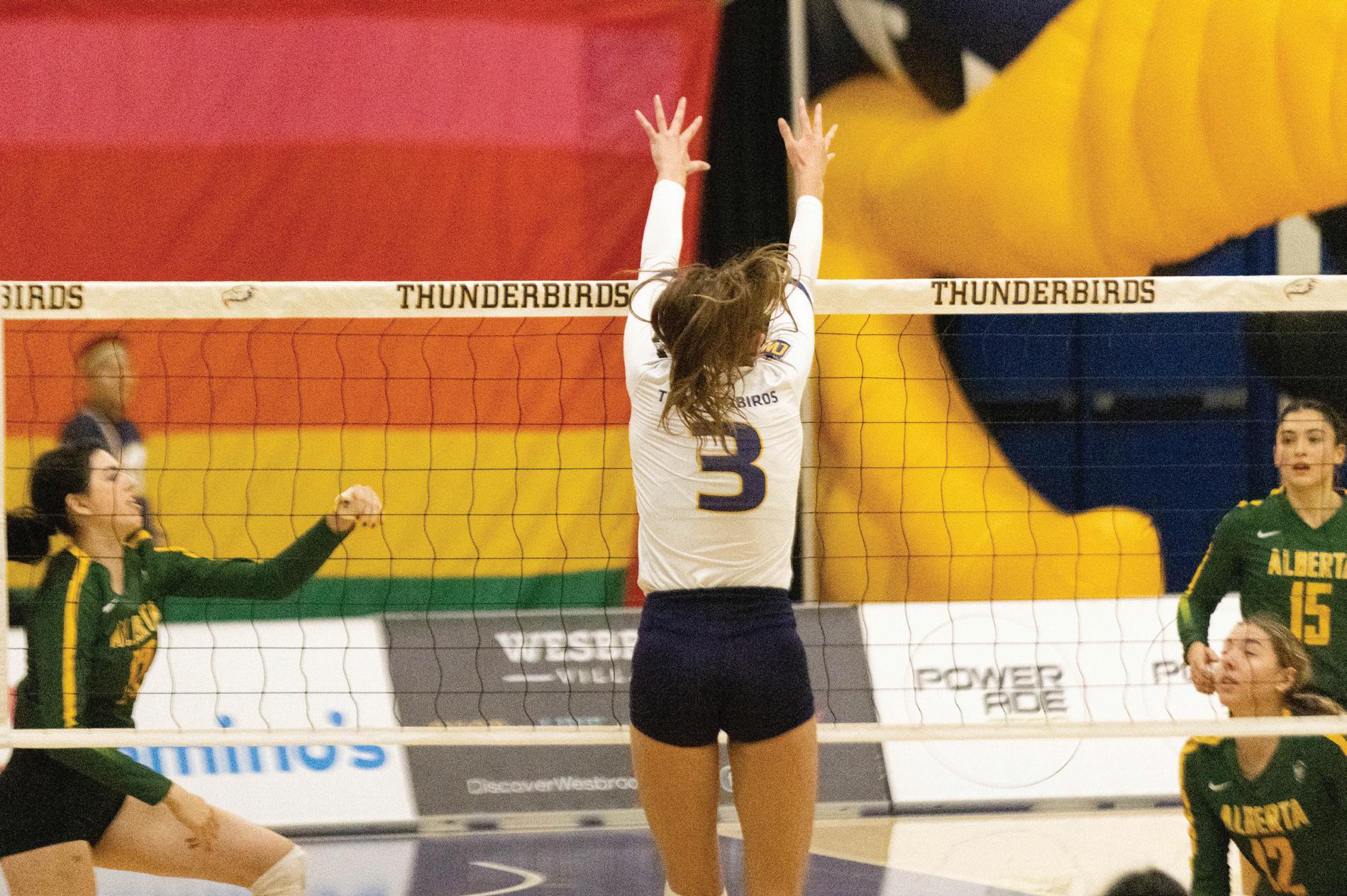
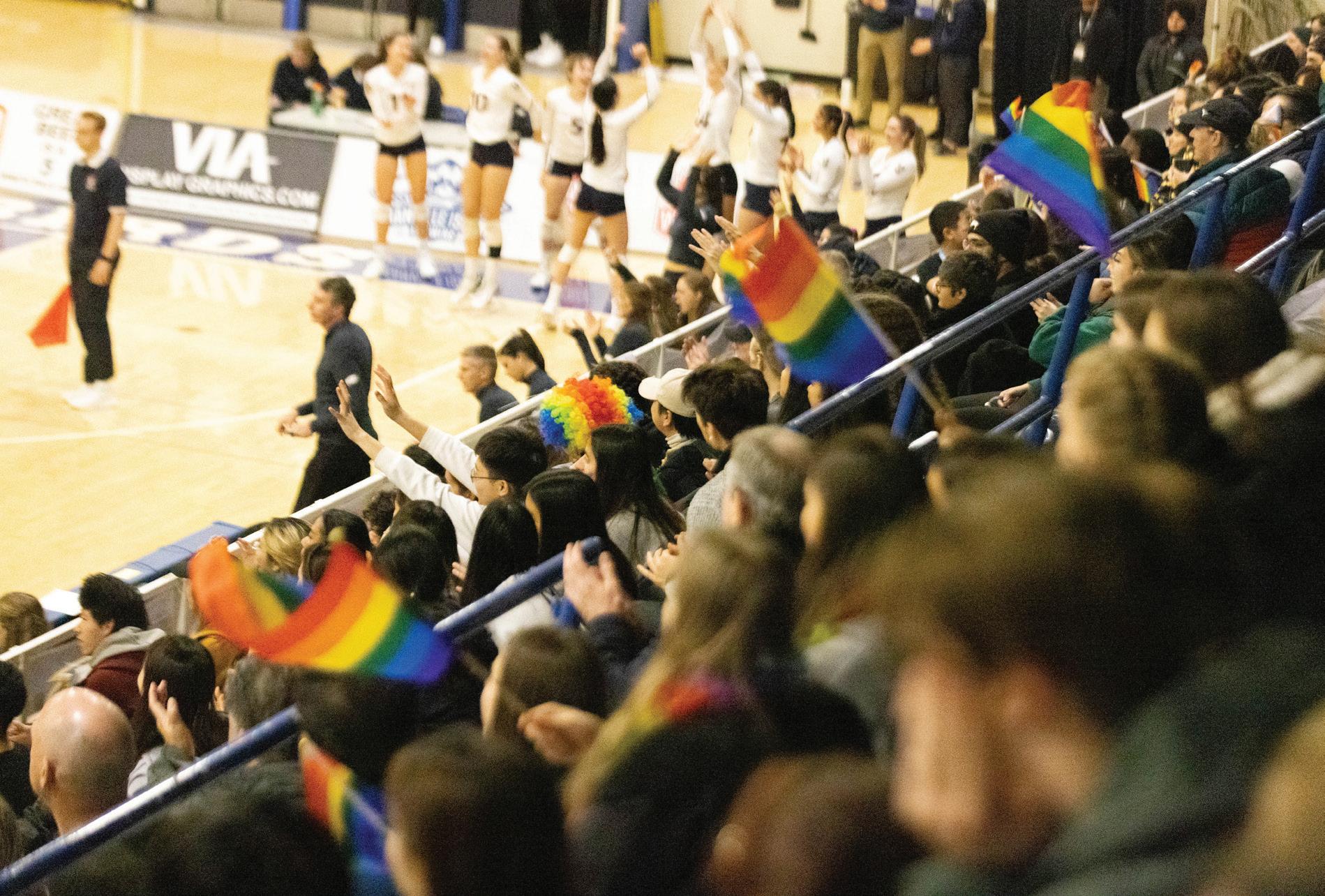
team. “As a team, we wanted to create a space that was super inclusive to everybody and any body. I know sports sometimes can be a super intimidating place for anybody, but I also think that LGBTQIA2S+ community really needs to see that this is a place for them,” she said.
The men’s team, which took the floor after the women, fell short of success but had their own share of outstanding performances. Michael Dowhaniuk singlehandedly scored 20 kills on the night and topped it off with 6 digs, while Matt Neaves managed 13 kills, 9 digs and 3 aces.
As the evening wound down, men’s volley ball head coach Mike Hawkins reflected on how sports events like Pride Night can serve as a vehicle for good. “I think sport, in general, can be a catalyst for positivity or negativity. There are both ends of that spectrum. I think if done correctly, if pushed in the right direction, sports is the greatest catalyst for love, for positivity, for celebration, for uniting different cultures, unit ing countries,” he said.
“Sport just brings people together, and if done positively, can really be a catalyst for change.” U
“Sport just brings people together, and if done positively, can really be a catalyst for change.”
“

